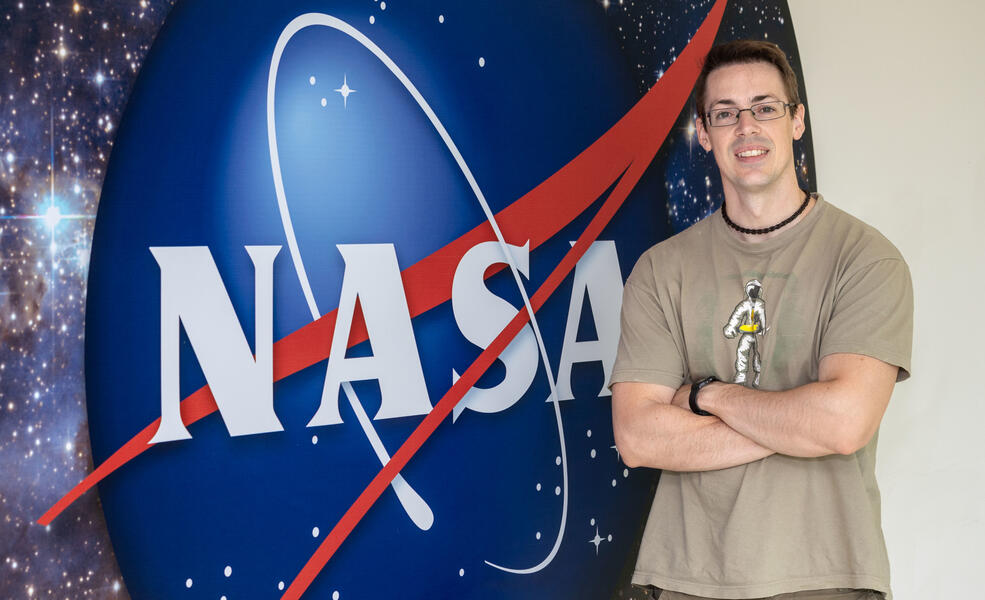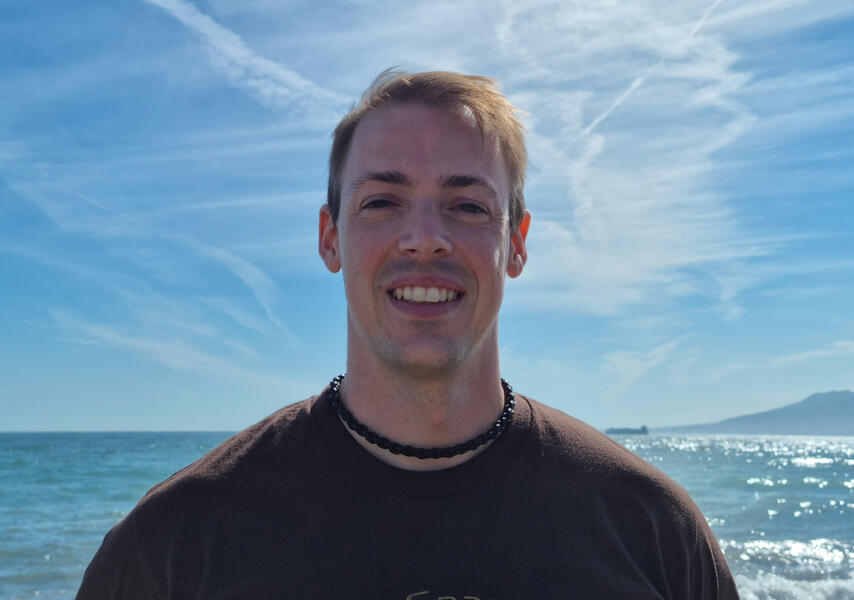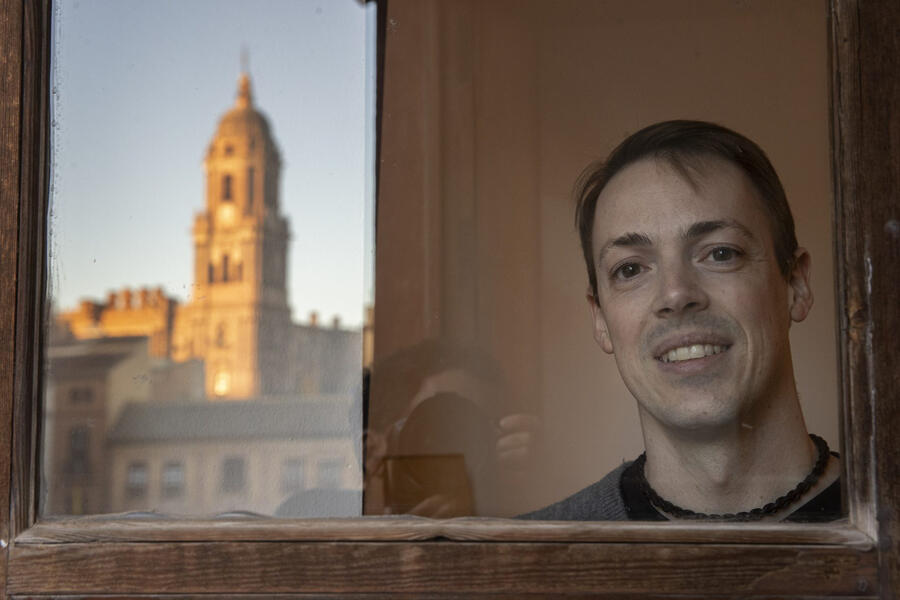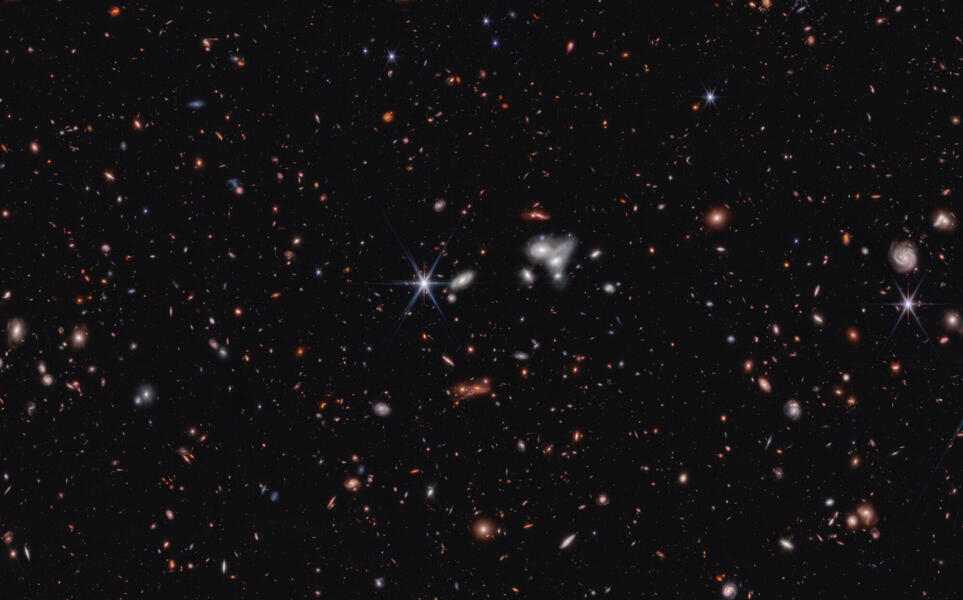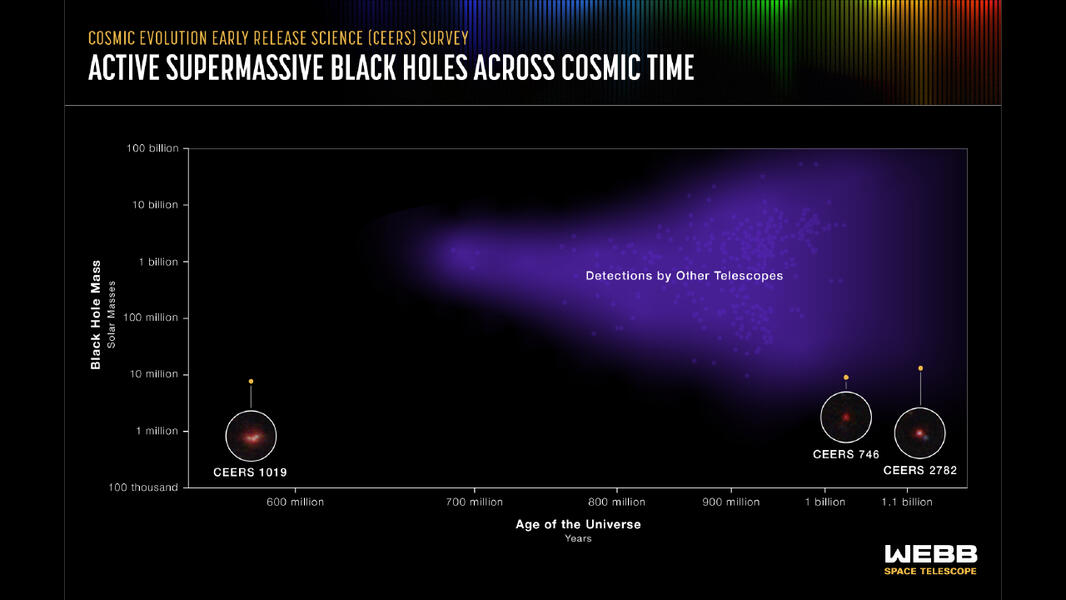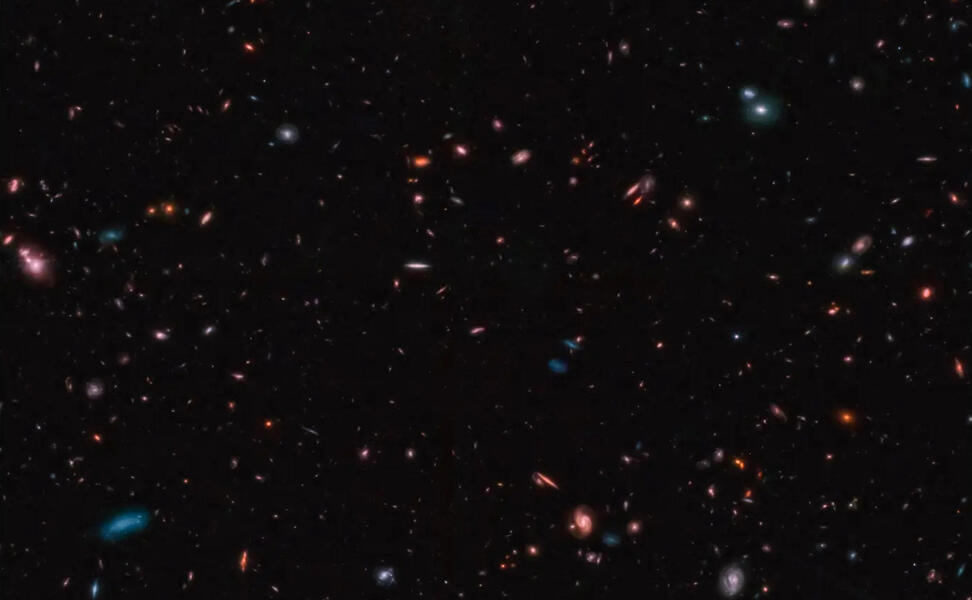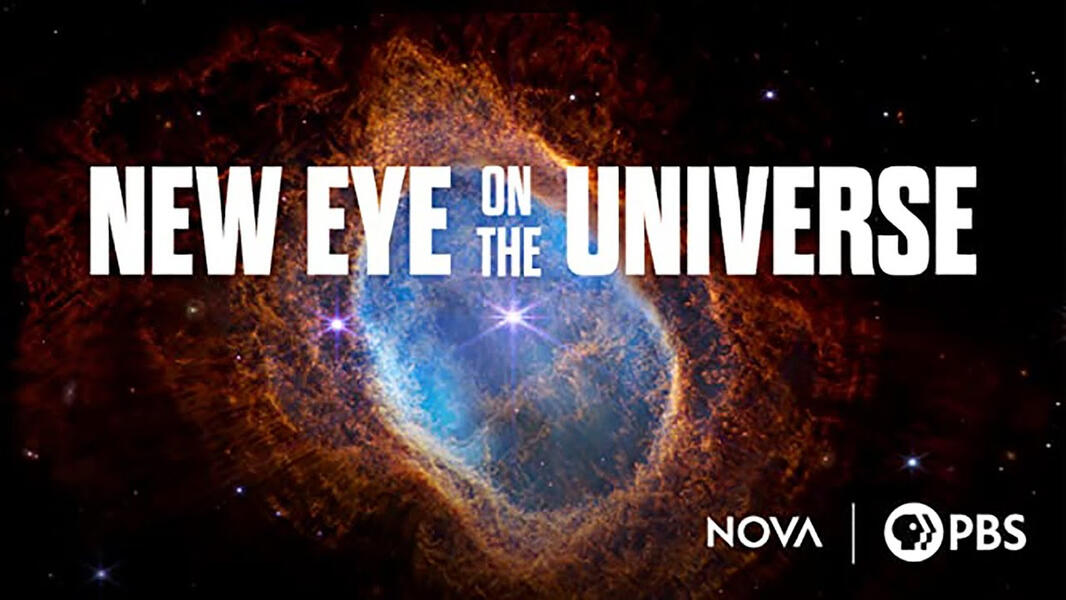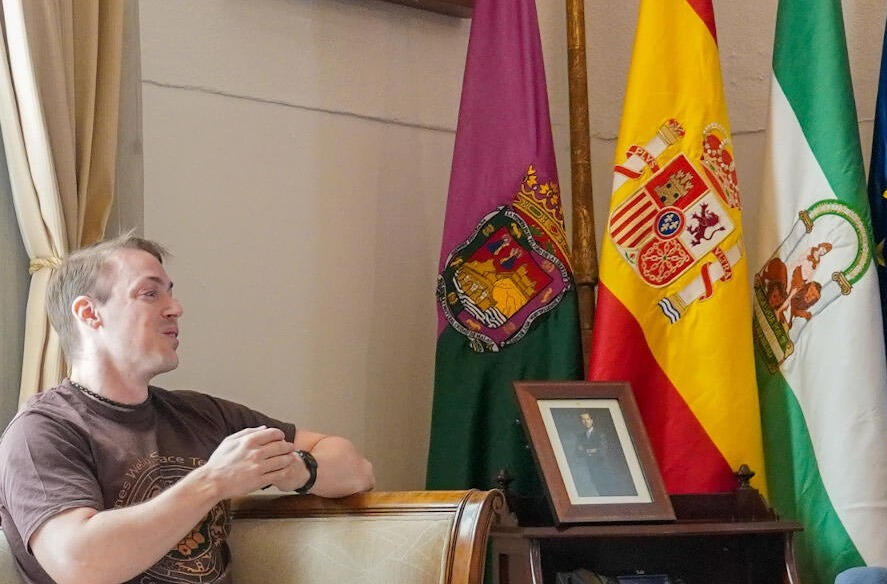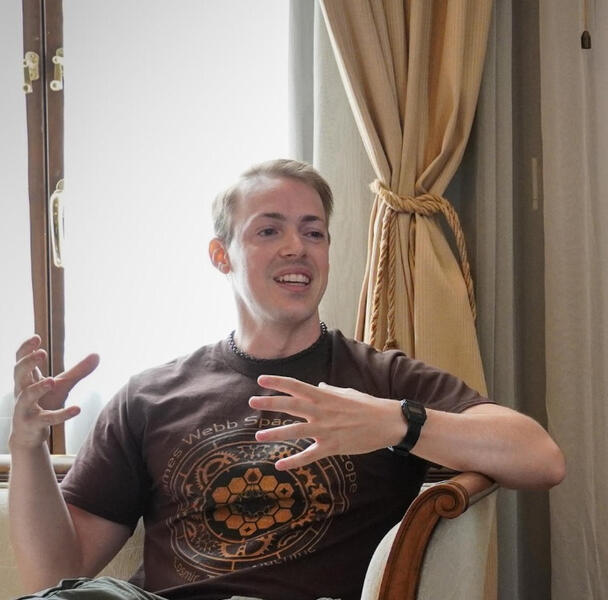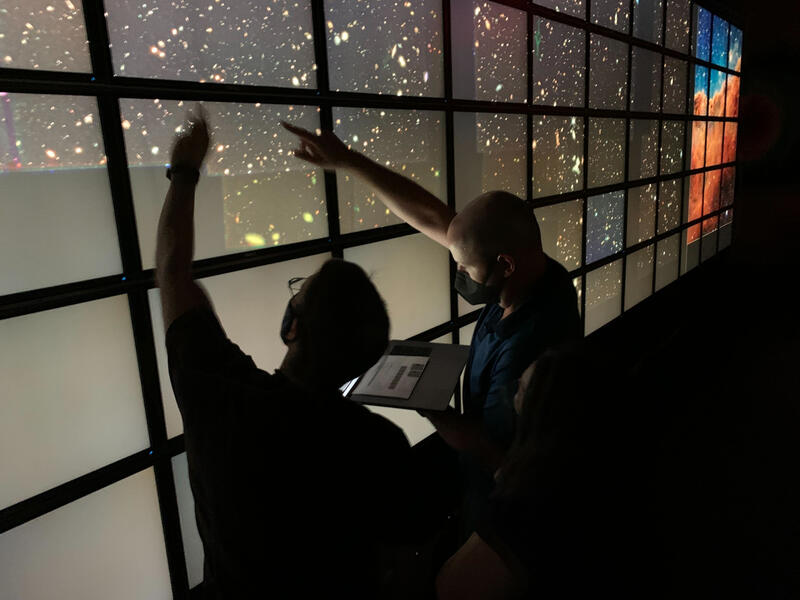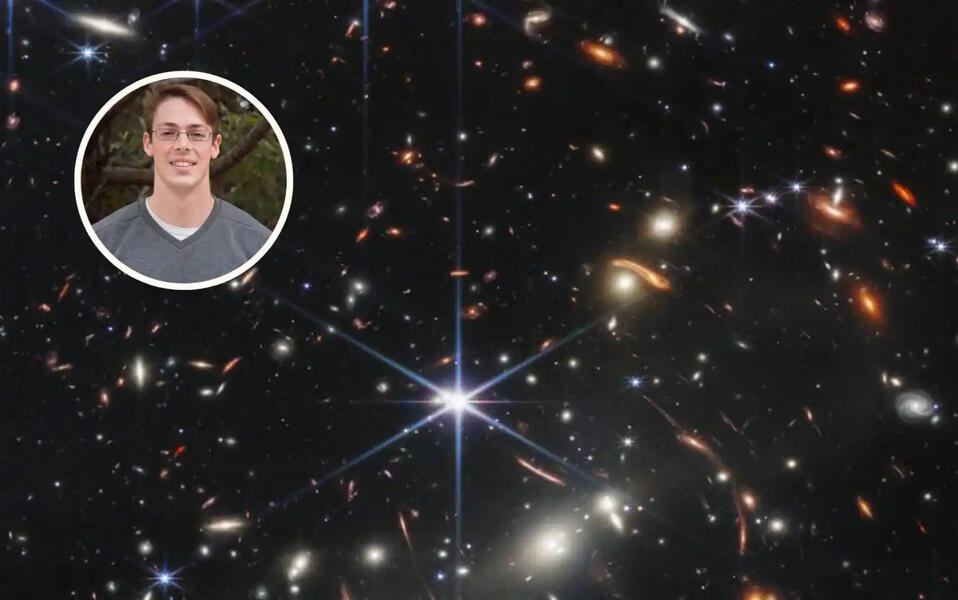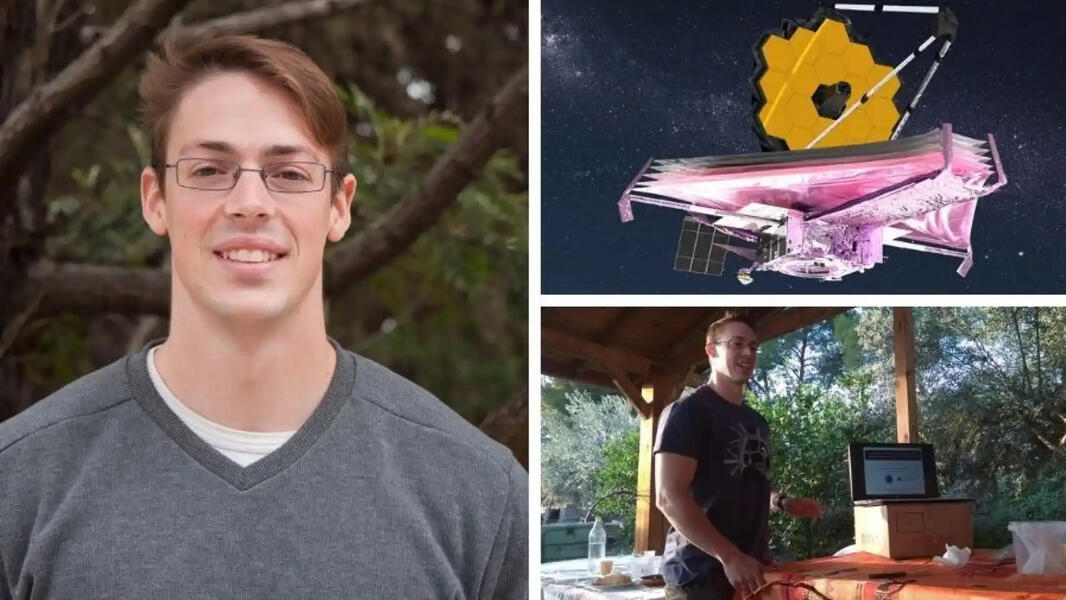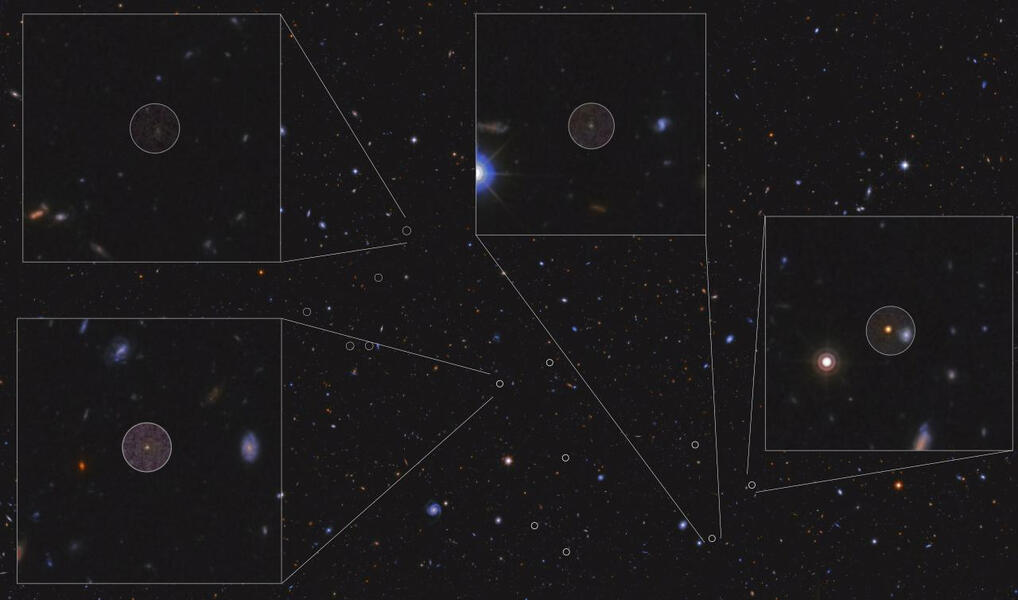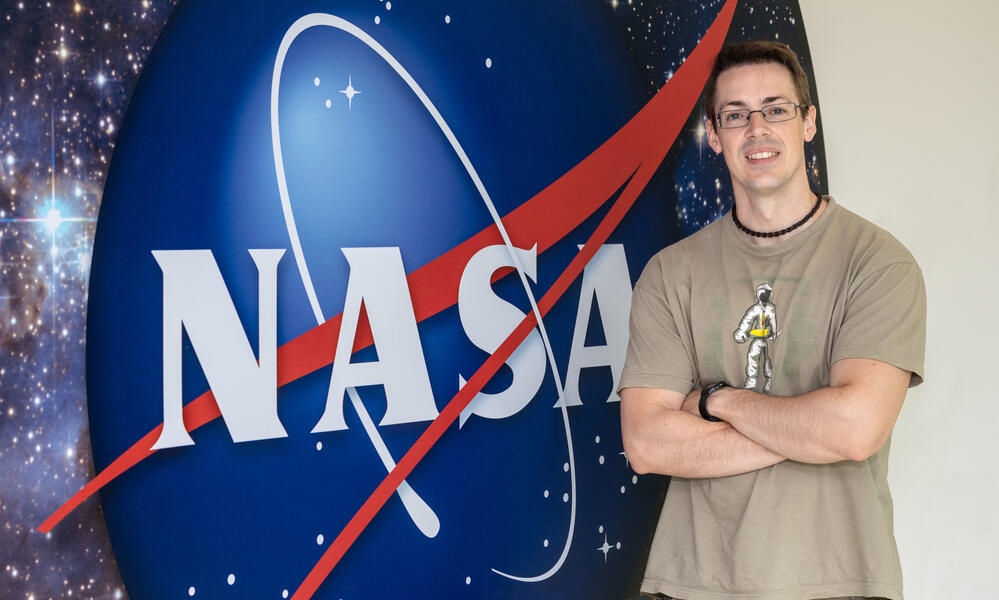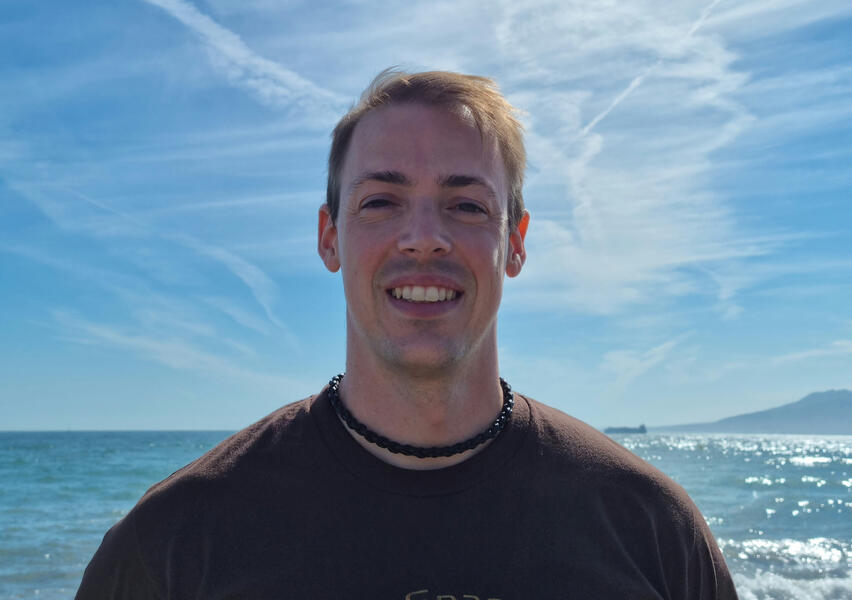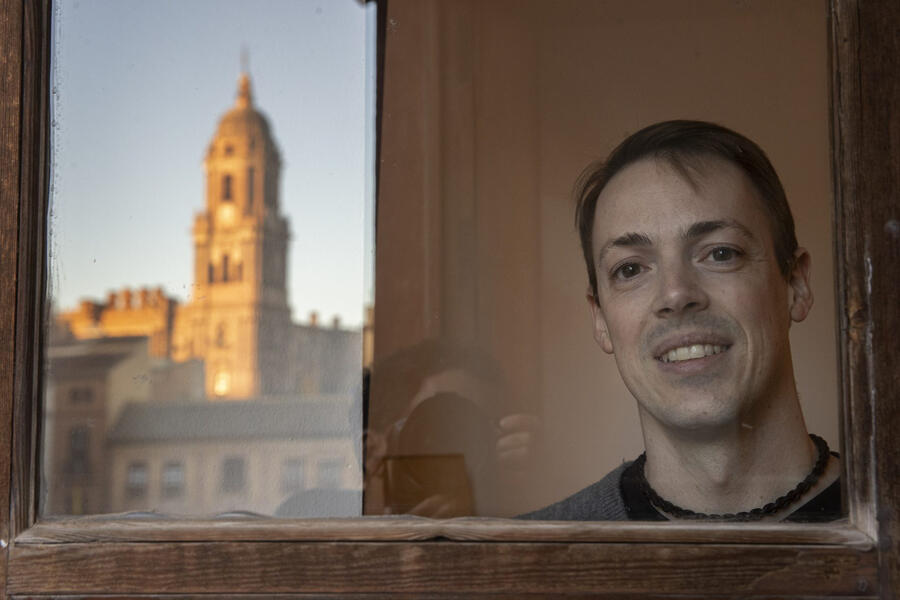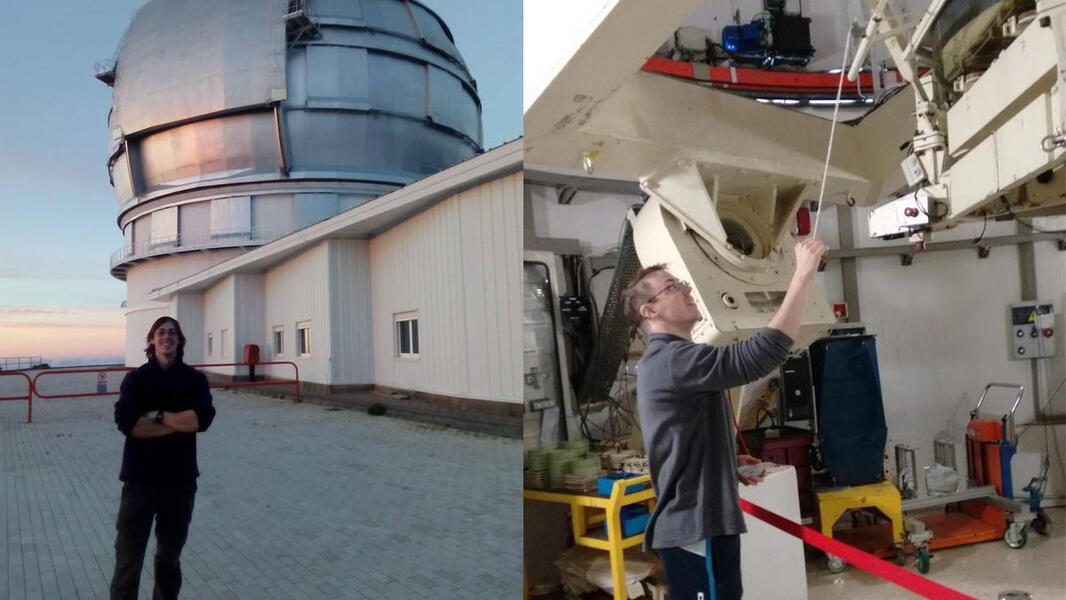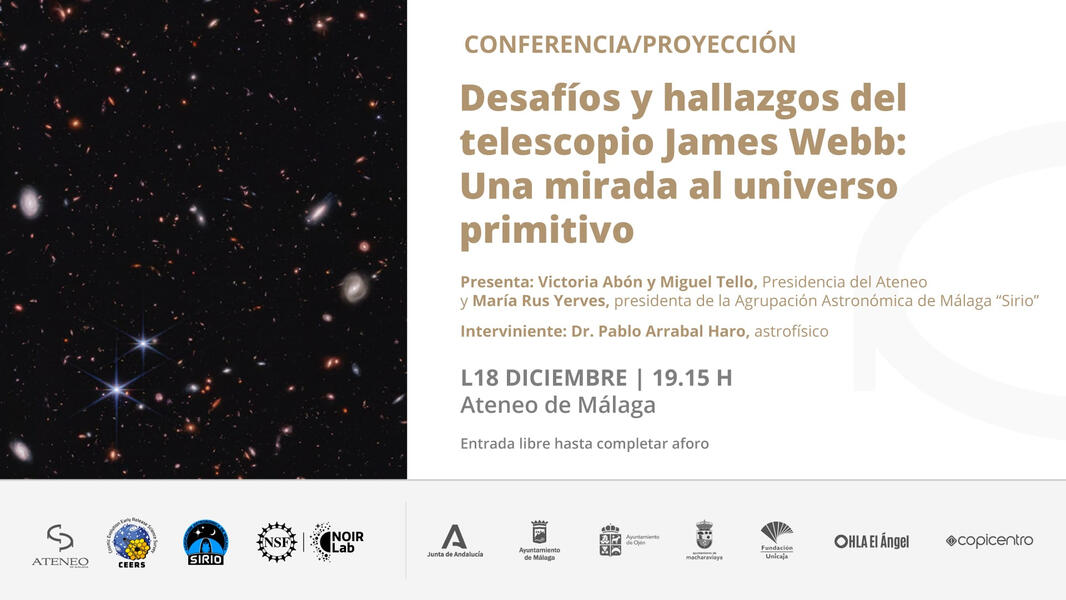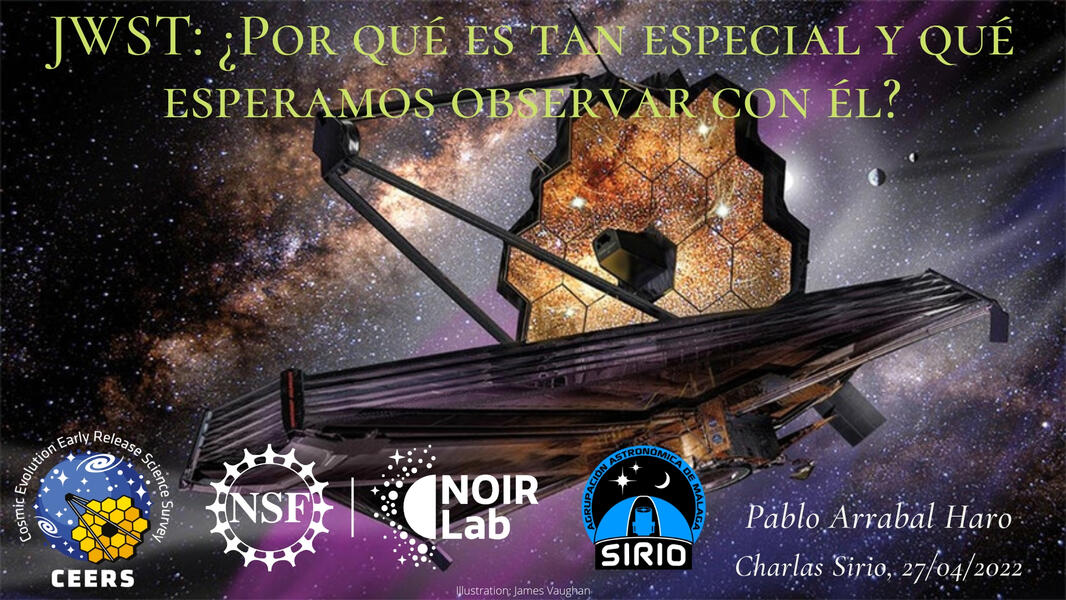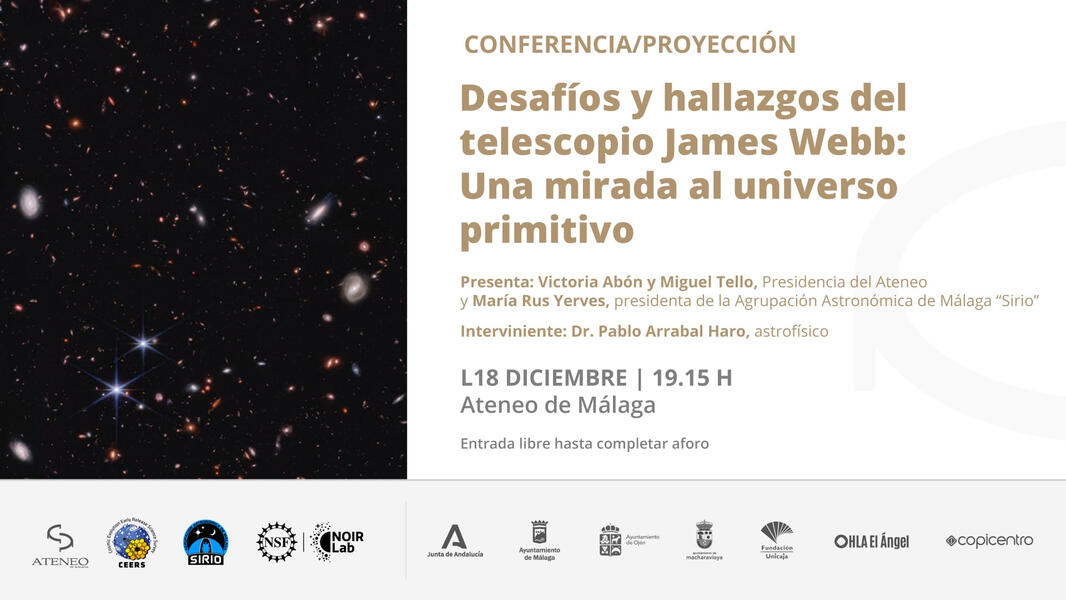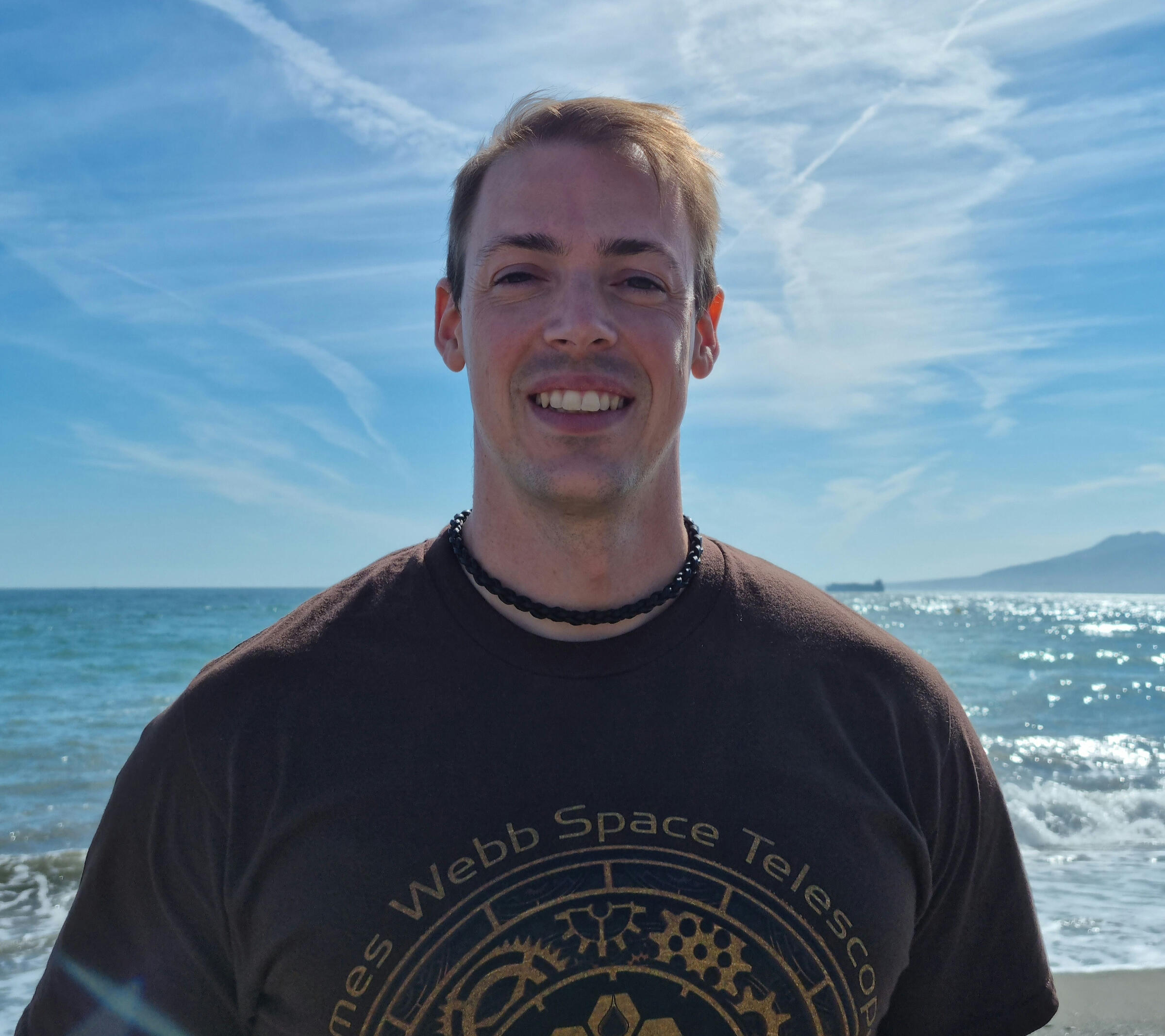
About Me
Hi, my name is Pablo. I am an astrophysicist from a wonderful city in the southern coastline of Spain called Málaga, currently living in Washington DC, where I work for the NASA Goddard Space Flight Center (GSFC).My scientific research is mainly focused on the study of galaxy formation and evolution in the very early Universe, for which I use the NASA/ESA/CSA's James Webb Space Telescope, whose unmatched capabilities allow me to analyze some of the most distant galaxies observed to date.Apart from a cosmos wonderer, I am also a persistent lifter, an avid reader, a board games enthusiast and a relentless optimistic.
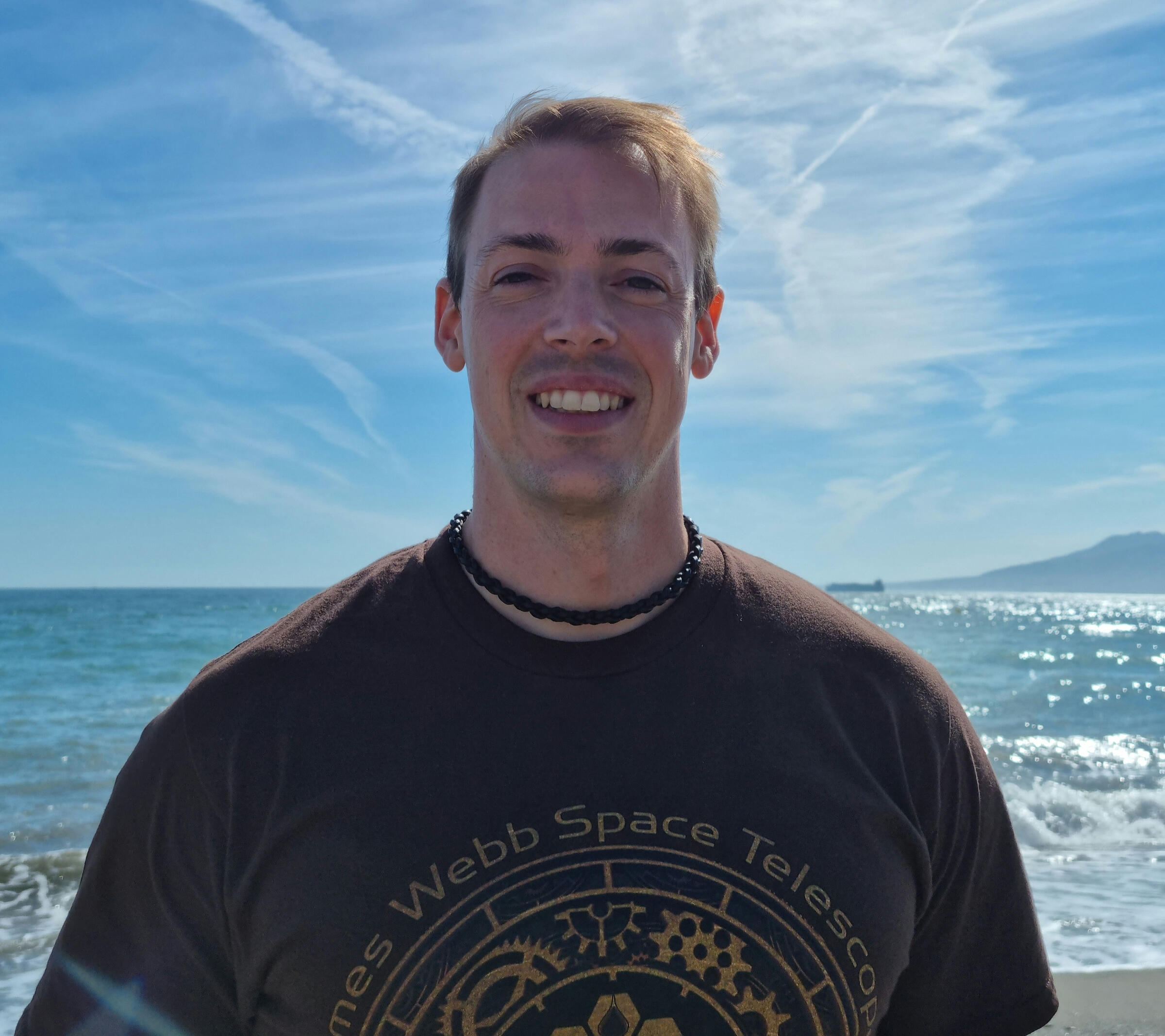
Sobre mí
Hola, soy Pablo, un astrofísico procedente de una maravillosa ciudad en la costa sur de España llamada Málaga, actualmente viviendo en Washington DC, donde trabajo para el Centro de Vuelo Espacial Goddard (GSFC) de la NASA.Mi trabajo de investigación está fundamentalmente enfocado en el estudio de la formación y evolución de galaxias en el universo primitivo, para lo cual utilizo el telescopio espacial NASA/ESA/CSA James Webb, cuyas inigualables características me permiten analizar algunas de las galaxias más lejanas observadas hasta la fecha.Aparte de un curioso del cosmos, también soy un persistente levantador de pesas, un ávido lector, un entusiasta de los juegos de mesa y un optimista sin remedio.
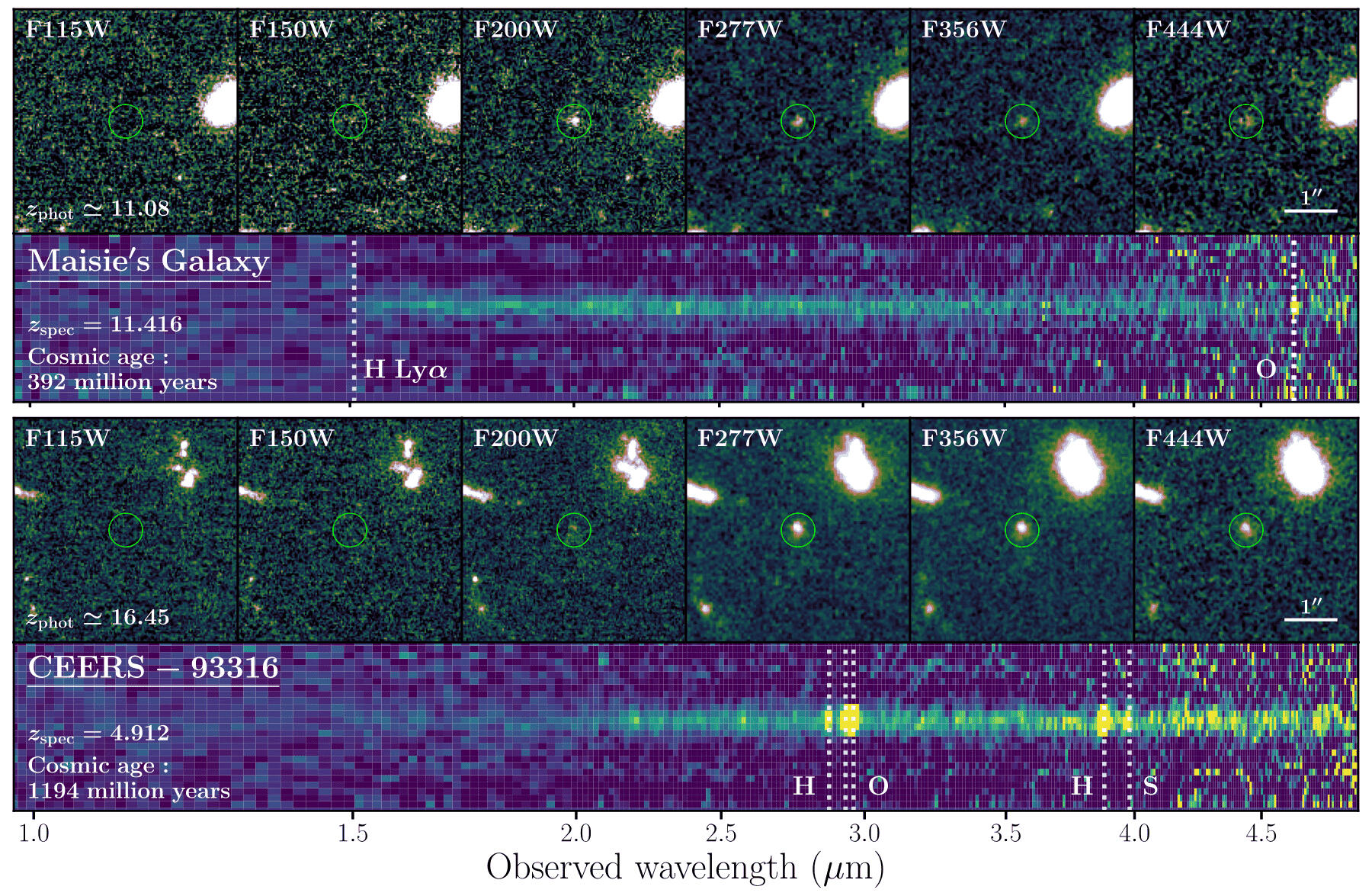
Research
My scientific interests span a large variety of topics related with galaxy formation and evolution, protoclusters and structure formation, stellar population modeling, machine learning, data reduction, etc. But my recent work has been especially dedicated to the spectroscopic analysis of ultradistant galaxies in the very early Universe, many of them never seen before until the advent of the JWST.A large fraction of my recent scientific studies have been carried out in the frame of the Cosmic Evolution Early Release Science (CEERS) project, one of the very first surveys of the deep universe observed with the JWST, for which I have lead the spectroscopic efforts with the NIRSpec instrument. Along the way we have provided pre-launch simulations, scientific products and tools to help the community with the data processing.Apart from my close involvement in CEERS, I am also the principal investigator of two other programs executed during the first year of observations with the JWST: one aiming to confirm some of the most promising ultradistant candidates found in the first deep imaging data, and another to study environmental effects on the largest observed galaxy overdensity at the end of the Epoch of Reionization.Among the most interesting results from my research is the confirmation of the first bright ultradistant galaxies at z > 11, including Maisie's Galaxy, only 390 million years after the Big Bang, when the Universe was less than 3% of its current age. It is important to make clear that there were already three more distant galaxies confirmed back then, but those in our work were the most distant bright (MUV < -20 AB) galaxies confirmed at the time. Additionally, our sample represented an important milestone, as one of the most surprising results found in the first JWST deep images is the overabundance of these bright ultradistant candidates, in stark disagreement with the predictions from the pre-JWST galaxy evolution models for the very early Universe.Moreover, in that same work we also refuted CEERS-93316, a very bright and controversial z ~ 16 candidate that would have set a new redshift record by a large margin and would have represented a serious challenge for our models to explain. We instead found that the object was at z = 4.912, an epoch a thousand million years later than the originally predicted based on the imaging data only. We showed that, under peculiar circumstances (including a combination of strong reddening and emission lines at that specific redshift), that source mimics the emission pattern of an ultradistant galaxy in the imaging data. This finding was very educational as it made the high-z community aware of the existence of this rare but possible type of interlopers at very high redshifts.

Investigación
Mis intereses científicos abarcan una gran variedad de materias relacionadas con la formación y evolución de galaxias, protocúmulos y formación de estructuras, ajuste de poblaciones estelares, machine learning, reducción de datos, etc. Pero mi trabajo reciente ha estado especialmente dedicado al análisis espectroscópico de galaxias ultralejanas en el universo muy temprano, muchas de ellas nunca vistas antes hasta la llegada del JWST.Gran parte de mis estudios recientes han sido llevados a cabo en el marco del proyecto CEERS (Cosmic Evolution Early Release Science), uno de los primerísimos cartografiados del universo profundo observados con el JWST, para el cual he liderado los esfuerzos dedicados a la espectroscopía con el instrumento NIRSpec. Durante este proceso hemos proporcionado simulaciones, productos científicos y herramientas para ayudar a la comunidad con el procesamiento de datos.Aparte de mi fuerte implicación en CEERS, también soy el investigador principal de otros dos programas ejecutados durante el primer año de observaciones con el JWST: uno enfocado a intentar confirmar algunos de los candidatos más prometedores a galaxias ultralejanas en los primeros datos de imagen profunda, y otro para estudiar los efectos del ambiente en el mayor protocúmulo de galaxias observado al final de la Era de la Reionización.Entre los resultados más interesantes de mi investigación cabe destacar la confirmación de las primeras galaxias ultralejanas brillantes a z > 11, incluyendo Maisie's Galaxy, tan solo 390 millones de años después del Big Bang, cuando el universo tenía menos de un 3% de su edad actual. Es importante aclarar que ya había tres galaxias más lejanas confirmadas en ese momento, pero las presentadas en nuestro trabajo eran las galaxias más lejanas brillantes (MUV < -20 AB) y representaron un hito importante debido a que uno de los resultados más sorprendentes encontrados en las primeras imágenes profundas de JWST es la sobreabundancia de candidatos a galaxias brillantes ultralejanas, en desacuerdo con las predicciones para el universo primitivo de los modelos de evolución de galaxias pre-JWST.Además, en ese mismo trabajo también refutamos el objeto CEERS-93316, un controvertido candidato a z ~ 16 muy brillante que habría batido el récord de desplazamiento al rojo por mucho y habría supuesto un desafío serio para poder explicar su existencia dentro de nuestros modelos. En su lugar, nosotros encontramos que el objeto está realmente a z = 4.912, una época mil millones de años posterior a la originalmente predicha basándose solo en los datos de imagen. En nuestro trabajo mostramos que, bajo circustancias muy particulares (incluyendo la combinación de un fuerte enrojecimiento por polvo y fuertes líneas de emisión a ese desplazamiento al rojo en concreto), esta fuente imita el patrón de emisión de una galaxia ultralejana en los datos de imagen. Este hallazgo fue muy educativo, puesto que puso a la comunidad de alto z sobre aviso acerca de la existencia de este raro pero posible tipo de objetos intrusos en las muestras a muy alto desplazamiento al rojo.
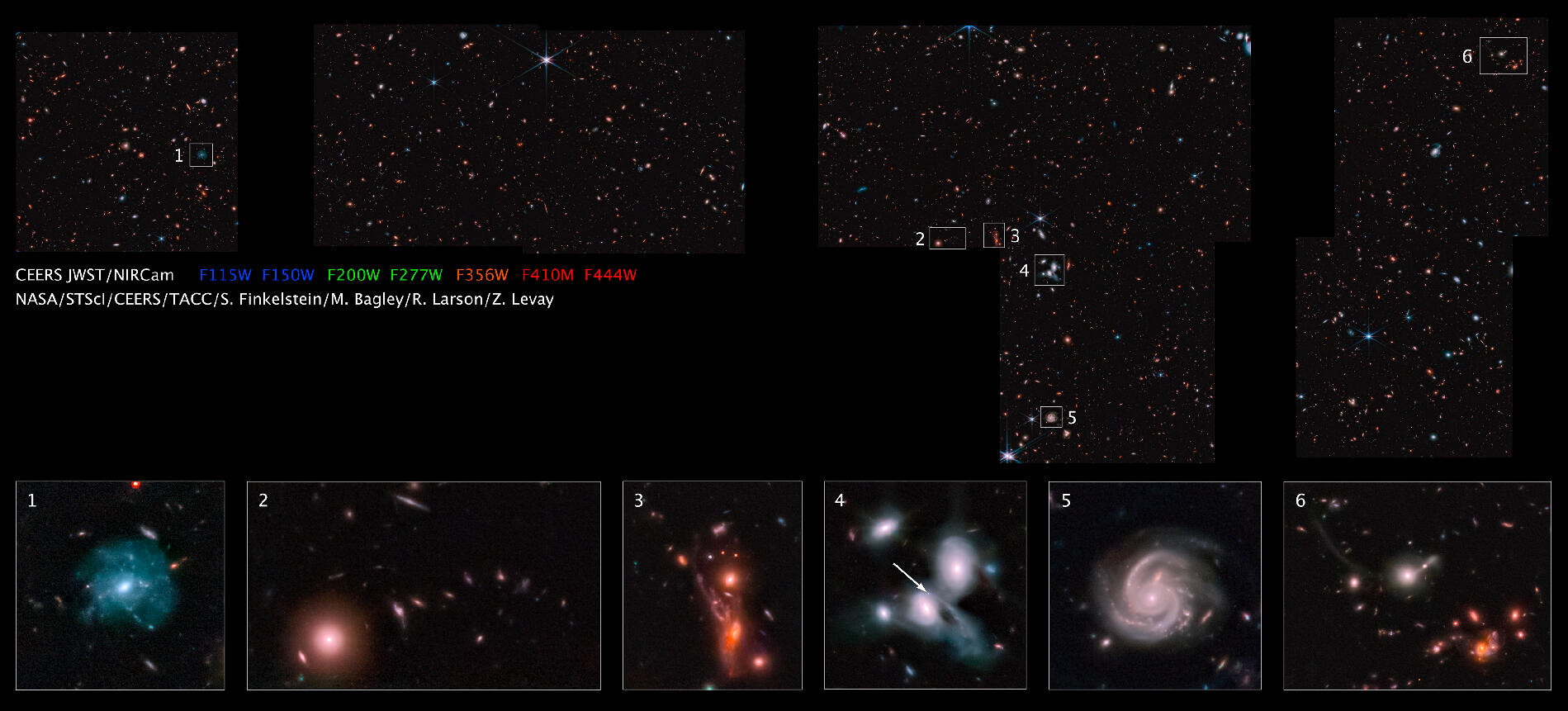
Press & Media
The number of press articles reporting interesting results from different JWST studies I am part of is (thanks to my awesome collaborators) huge. The compilation below is limited to part of the media coverage of my direct work or where I explicitly appear:

elDiario.es: El español que ve 'nacer' el universo: “Buscamos las galaxias primigenias formadas tras el Big Bang”

El Español de Málaga: Pablo Arrabal, un malagueño en la NASA: estudiará las galaxias más lejanas y antiguas del universo

EFE news: Pablo Arrabal, astrofísico: “Aún estamos lejos de poder confirmar vida extraterrestre”
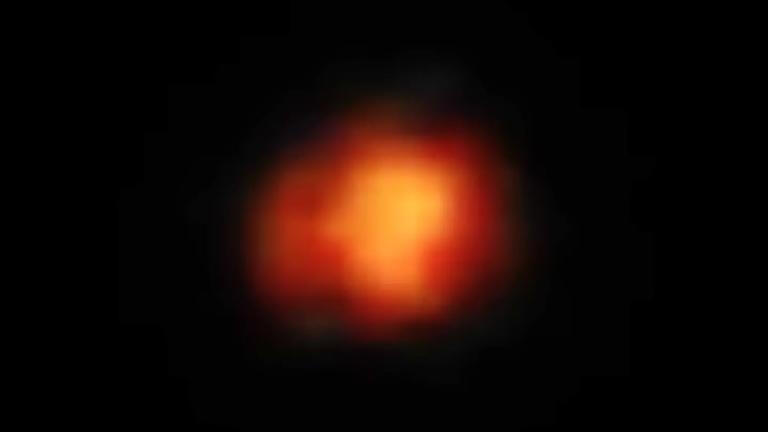
IAC press: El James Webb observa las primeras galaxias del Universo y descubre una “impostora”

NOIRLab press: Peering Back to the Early Universe: A Story of Confirmation and Refutation

UT Austin press: Astronomers Confirm Maisie’s Galaxy is Among Earliest Ever Observed

NASA press: Webb Detects Most Distant Active Supermassive Black Hole to Date

Big Think: Did the most distant galaxy “candidates” survive JWST’s ultimate test?

NOVA | PBS Documentary: New Eye on the Universe

Diario Sur: 100 malagueños de 2022

Canal Sur Radio | Días D Andalucía: Pablo Arrabal, el astrofísico andaluz que mira el universo desde el telescopio espacial James Webb

Diario Sur: Pablo Arrabal Haro, un malagueño en la 'sala de partos' de las galaxias

El Español de Málaga: El malagueño en el James Webb: "Esta imagen marca el inicio de una nueva era en la observación astronómica"

El Español de Málaga: Pablo Arrabal, el astrofísico malagueño en Estados Unidos detrás del mayor telescopio enviado al espacio

La Opinión de Málaga: Las galaxias lejanas, cada vez más cerca gracias a un malagueño

IAC press: El Gran Telescopio Canarias descubre el mayor cúmulo de galaxias conocido del Universo primitivo
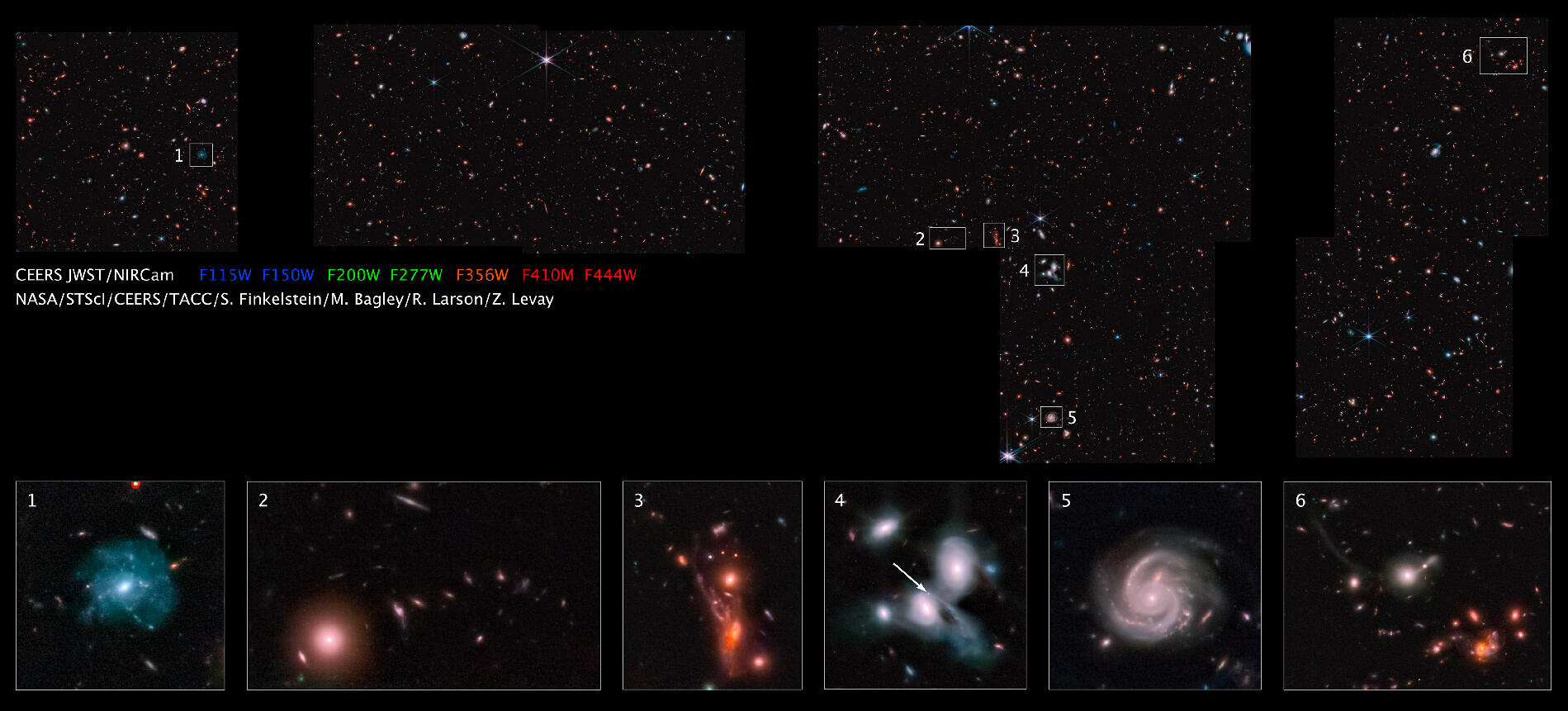
Prensa y Medios
El número de artículos de prensa informando sobre resultados interesantes de diferentes estudios con el JWST de los que formo parte es (gracias a mis increíbles colaboradores) enorme. La selección aquí mostrada se limita a parte de la cobertura mediática de mi trabajo directo o en la que aparezco explícitamente:

elDiario.es: El español que ve 'nacer' el universo: “Buscamos las galaxias primigenias formadas tras el Big Bang”

El Español de Málaga: Pablo Arrabal, un malagueño en la NASA: estudiará las galaxias más lejanas y antiguas del universo

EFE noticias: Pablo Arrabal, astrofísico: “Aún estamos lejos de poder confirmar vida extraterrestre”

IAC press: El James Webb observa las primeras galaxias del Universo y descubre una “impostora”

NOIRLab press: Peering Back to the Early Universe: A Story of Confirmation and Refutation

UT Austin press: Astronomers Confirm Maisie’s Galaxy is Among Earliest Ever Observed

NASA press: Webb Detects Most Distant Active Supermassive Black Hole to Date

Big Think: Did the most distant galaxy “candidates” survive JWST’s ultimate test?

NOVA | PBS Documentary: New Eye on the Universe

Diario Sur: 100 malagueños de 2022

Canal Sur Radio | Días D Andalucía: Pablo Arrabal, el astrofísico andaluz que mira el universo desde el telescopio espacial James Webb

Diario Sur: Pablo Arrabal Haro, un malagueño en la 'sala de partos' de las galaxias

El Español de Málaga: El malagueño en el James Webb: "Esta imagen marca el inicio de una nueva era en la observación astronómica"

El Español de Málaga: Pablo Arrabal, el astrofísico malagueño en Estados Unidos detrás del mayor telescopio enviado al espacio

La Opinión de Málaga: Las galaxias lejanas, cada vez más cerca gracias a un malagueño

IAC press: El Gran Telescopio Canarias descubre el mayor cúmulo de galaxias conocido del Universo primitivo
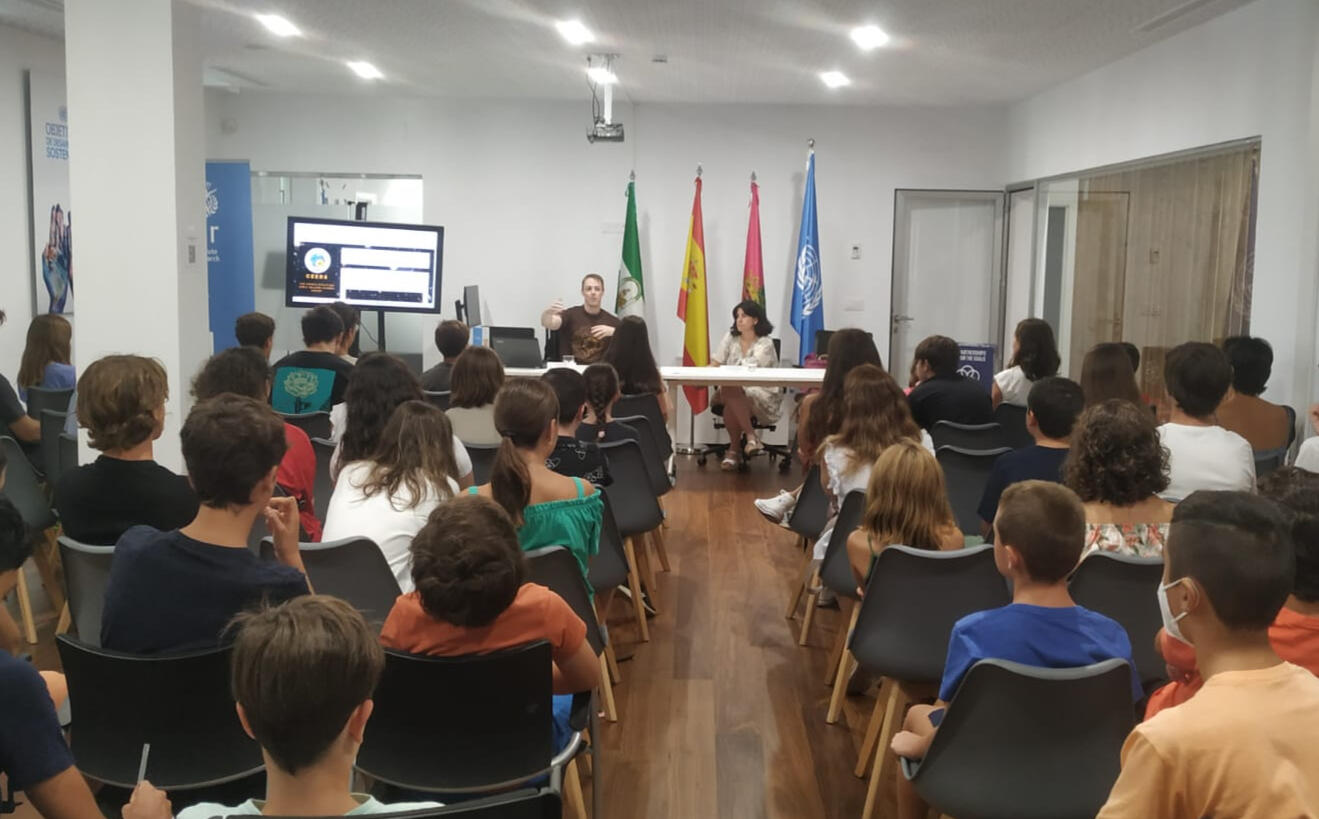
Outreach
I unfortunately cannot dedicate as much time as I would like to outreach events at this point within my usually demanding research activity, but every now and then I like to make short posts in Facebook and Instagram (usually in Spanish) talking about interesting astronomical findings or milestones that might go unnoticed in the mainstream media.Occasionally, nonetheless, I can take part in a few more dedicated outreach events:

Public talk at Ateneo de Málaga: Desafíos y hallazgos del telescopio James Webb: Una mirada al universo primitivo. December 2023

NOVA | PBS Documentary: New Eye on the Universe. February 2023
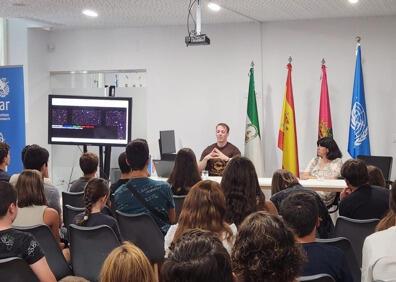
Outreach meeting with youths from the Málaga ASA association. September 2022

Charlas Sirio Online: "JWST: ¿Por qué es tan especial y qué esperamos observar con él?" April 2022
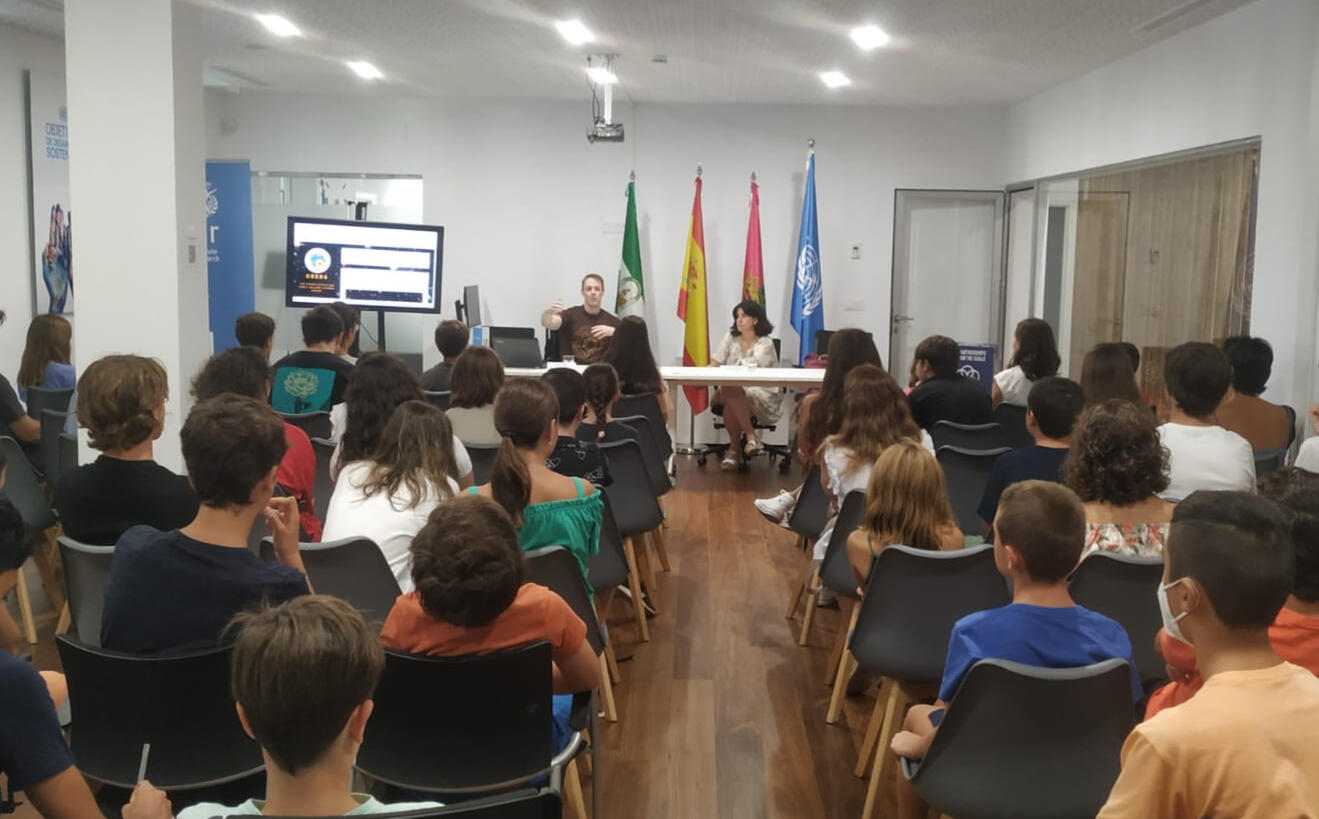
Divulgación
Desafortunadamente, en la actualidad no puedo dedicar tanto tiempo como me gustaría a eventos de divulgación dentro de mi normalmente demandante actividad científica, pero de vez en cuando me gusta escribir pequeñas publicaciones en Facebook e Instagram (normalmente en español) hablando sobre hitos y hallazgos astronómicos interesantes que pueden pasar desapercibidos en los medios de comunicación habituales.Ocasionalmente, no obstante, sí que puedo participar en algún que otro evento divulgativo más dedicado:

Conferencia Ateneo de Málaga: Desafíos y hallazgos del telescopio James Webb: Una mirada al universo primitivo. Diciembre 2023

Documental en NOVA | PBS: New Eye on the Universe. Febrero 2023

Encuentro con jóvenes de la asociación ASA de Málaga. Septiembre 2022

Charlas Sirio Online: "JWST: ¿Por qué es tan especial y qué esperamos observar con él?" Abril 2022
List of Publications
Refereed: 38; Submitted: 18; First author: 4 (updated as of November 2023)
First author:
P. Arrabal Haro, M. Dickinson, S. L. Finkelstein, J. S. Kartaltepe, and 33 coauthors. Confirmation and refutation of very luminous galaxies in the early Universe. Nature, 622, 707, 2023
P. Arrabal Haro, M. Dickinson, S. L. Finkelstein, S. Fujimoto, and 44 coauthors. Spectroscopic Confirmation of CEERS NIRCam-selected Galaxies at z ≃ 8-10. ApJL, 951, L22, 2023
P. Arrabal Haro, J. M. Rodríguez Espinosa, C. Muñoz-Tuñón, D. Sobral, and 5 coauthors. Differences and similarities of stellar populations in LAEs and LBGs at z ~ 3.4-6.8. MNRAS, 495, 1807, 2020
P. Arrabal Haro, J. M. Rodríguez Espinosa, C. Muñoz-Tuñón, P. G. Pérez-González, and 14 coauthors. A simultaneous search for high-z LAEs and LBGs in the SHARDS survey. MNRAS, 478, 3740, 2018
Key contribution as coauthor:
E. Lambrides, R. Larson, T. Hutchison, P. Arrabal Haro, and 49 coauthors. Discovery of Multiply Ionized Iron Emission Powered by an Active Galactic Nucleus in a z~7 Little Red Dot. arXiv.2509.09607, 2025
S. L. Finkelstein, M. B. Bagley, P. Arrabal Haro, M. Dickinson, and 101 coauthors. The Cosmic Evolution Early Release Science Survey (CEERS). ApJL, 983, L4, 2025
S. Lu, E. Daddi, C. Maraston, M. Dickinson, P. Arrabal Haro, and 25 coauthors. Strong spectral features from asymptotic giant branch stars in distant quiescent galaxies. Nature Astronomy, 9, 128, 2025
L. Bisigello, G. Gandolfi, A. Feltre, P. Arrabal Haro, and 23 coauthors. Spectroscopic confirmation of a dust-obscured, possibly metal-rich dwarf galaxy at z ~ 5. A&A, 693, L18, 2025
L. Napolitano, M. Castellano, L. Pentericci, P. Arrabal Haro, and 23 coauthors. Seven wonders of Cosmic Dawn: JWST confirms a high abundance of galaxies and AGN at z ≃ 9–11 in the GLASS field. A&A, 693, A50, 2025
I. Jung, S. L. Finkelstein, P. Arrabal Haro, M. Dickinson, and 30 coauthors. CEERS: Diversity of Lyα Emitters during the Epoch of Reionization. ApJ, 967, 73, 2024
A. L. González-Morán, P. Arrabal Haro, C. Muñoz-Tuñón, J. M. Rogríguez-Espinosa, and 14 coauthors. The PAU survey: classifying low-z SEDs using Machine Learning clustering. MNRAS, 524, 3569, 2023
D. D. Kocevski, M. Onoue, K. Inayoshi, J. R. Trump, P. Arrabal Haro, and 36 coauthors. Hidden Little Monsters: Spectroscopic Identification of Low-mass, Broad-line AGNs at z > 5 with CEERS. ApJL, 954, L4, 2023
R. L. Larson, S. L. Finkelstein, D. D. Kocevski, T. A. Hutchison, J. R. Trump, P. Arrabal Haro, and 47 coauthors. A CEERS Discovery of an Accreting Supermassive Black Hole 570 Myr after the Big Bang: Identifying a Progenitor of Massive z > 6 Quasars. ApJL, 953, L29, 2023
S. Fujimoto, P. Arrabal Haro, M. Dickinson, S. L. Finkelstein, and 40 coauthors. CEERS Spectroscopic Confirmation of NIRCam-selected z ≳ 8 Galaxy Candidates with JWST/NIRSpec: Initial Characterization of Their Properties. ApJL, 949, L25, 2023
J. R. Trump, P. Arrabal Haro, R. C. Simons, B. E. Backhaus, and 62 coauthors. The Physical Conditions of Emission-line Galaxies at Cosmic Dawn from JWST/NIRSpec Spectroscopy in the SMACS 0723 Early Release Observations. ApJ, 945, 35, 2023
S. L. Finkelstein, M. B. Bagley, P. Arrabal Haro, M. Dickinson, and 118 coauthors. A Long Time Ago in a Galaxy Far, Far Away: A Candidate z ~ 12 Galaxy in Early JWST CEERS Imaging. ApJL, 940, L55, 2022
K. Z. Arellano-Córdova, D. A. Berg, J. Chisholm, P. Arrabal Haro, and 8 coauthors. A First Look at the Abundance Pattern-O/H, C/O, and Ne/O-in z > 7 Galaxies with JWST/NIRSpec. ApJL, 940, L23, 2022
R. Calvi, H. Dannerbauer, P. Arrabal Haro, J. M. Rodríguez Espinosa, and 3 coauthors. Probing the existence of a rich galaxy overdensity at z = 5.2. MNRAS, 502, 4558, 2021
Coauthor:
G. Gandolfi, G. Rodighiero, M. Castellano, A. Fontana, and 33 coauthors. Mysteries of Capotauro -- investigating the puzzling nature of an extreme F356W-dropout. arXiv.2509.01664, 2025
L. Napolitano, L. Pentericci, M. Dickinson, P. Arrabal Haro, and 27 coauthors. Lyα visibility from z = 4.5 to 11 in the UDS field: evidence for a high neutral hydrogen fraction and small ionized bubbles at z ~ 7. arXiv.2508.14171, 2025
H. B. Akins, C. M. Casey, J. B. Champagne, O. Cooper, and 13 coauthors. JWST+ALMA reveal the ISM kinematics and stellar structure of MAMBO-9, a merging pair of DSFGs in an overdense environment at z = 5.85. arXiv.2508.06607, 2025
A. J. Taylor, V. Kokorev, D. D. Kocevski, H. B. Akins, and 48 coauthors. CAPERS-LRD-z9: A Gas-enshrouded Little Red Dot Hosting a Broad-line Active Galactic Nucleus at z = 9.288. ApJL, 989, L7, 2025
L. Napolitano, M. Castellano, L. Pentericci, C. Vignali, and 32 coauthors. The Dual Nature of GHZ9: Coexisting Active Galactic Nuclei and Star Formation Activity in a Remote X-Ray Source at z = 10.145. ApJ, 989, 75, 2025
C. T. Donnan, M. Dickinson, A. J. Taylor, P. Arrabal Haro, and 36 coauthors. Very bright, very blue, and very red: JWST CAPERS analysis of highly luminous galaxies with extreme UV slopes at z = 10. arXiv.2507.10518, 2025
A. M. Morales, S. L. Finkelstein, P. Arrabal Haro, M. B. Bagley, and 20 coauthors. Testing Photometric Techniques for Measuring the Rest-Frame UV Spectral Slope Against JWST PRISM Spectroscopy. arXiv.2507.03118, 2025
V. Kokorev, Ó. A. Chávez Ortiz, A. J. Taylor, S. L. Finkelstein, and 37 coauthors. CAPERS Observations of Two UV-bright Galaxies at z > 10. More Evidence for Bursting Star Formation in the Early Universe. ApJL, 988, L10, 2025
D. Burgarella, V. Buat, P. Theulé, J. Zavala, and 34 coauthors. CEERS: Possibly forging the first dust grains in the universe: A population of galaxies with spectroscopically derived extremely low dust attenuation (GELDA) at 4.0 < z ≲ 11.4. A&A, 699, A336, 2025
N. J. Cleri, G. M. Olivier, B. E. Backhaus, J. Leja, and 23 coauthors. Optical Strong Line Ratios Cannot Distinguish Between Stellar Populations and Accreting Black Holes at High Ionization Parameters and Low Metallicities. arXiv.2506.21660, 2025
K. Hamblin, A. Kirkpatrick, B. E. Backhaus, G. Troiani, and 16 coauthors. AGNBoost: A Machine Learning Approach to AGN Identification with JWST/NIRCam+MIRI Colors and Photometry. arXiv.2506.03130, 2025
A. J. Taylor, S. L. Finkelstein, D. D. Kocevski, J. Jeon, and 47 coauthors. Broad-line AGNs at 3.5 < z < 6: The Black Hole Mass Function and a Connection with Little Red Dots. ApJ, 986, 165, 2025
Y. Guo, S. Jogee, E. Wise, K. Pritchett, and 25 coauthors. The Abundance and Properties of Barred Galaxies out to z ~ 4 Using JWST CEERS Data. ApJ, 985, 181, 2025
M. Llerena, L. Pentericci, L. Napolitano, S. Mascia, and 26 coauthors. The ionizing photon production efficiency of star-forming galaxies at z ~ 4–10. A&A, 698, A302, 2025
D. Dottorini, A. Calabrò, L. Pentericci, S. Mascia, and 22 coauthors. Evolution of the UV slope of galaxies at cosmic morning (z > 4): The properties of extremely blue galaxies. A&A, 698, A234, 2025
C. Papovich, J. W. Cole, W. Hu, S. L. Finkelstein, and 26 coauthors. Galaxies in the Epoch of Reionization Are All Bark and No Bite -- Plenty of Ionizing Photons, Low Escape Fractions. arXiv.2505.08870, 2025
S. Rojas-Ruiz, M. Bagley, G. Roberts-Borsani, T. Treu, and 11 coauthors. The BoRG-JWST Survey: Abundance and Mass-to-light Ratio of Luminous z = 7–9 Galaxies from Independent Sight Lines with NIRSpec. ApJ, 985, 80, 2025
M. Castellano, A. Fontana, E. Merlin, P. Santini, and 48 coauthors. Pushing JWST to the extremes: search and scrutiny of bright galaxy candidates at z≃15-30. arXiv.2504.05893, 2025
G. Roberts-Borsani, M. Bagley, S. Rojas-Ruiz, T. Treu, and 17 coauthors. The BoRG-JWST Survey: Program Overview and First Confirmations of Luminous Reionization-era Galaxies from Pure-parallel Observations. ApJ, 983, 18, 2025
B. E. Backhaus, N. J. Cleri, J. R. Trump, A. Kirkpatrick, and 16 coauthors. Emission-Line Diagnostics at z>4: [OIII]λ4363/Hγ. arXiv.2502.03519, 2025
G. Gandolfi, G. Rodighiero, L. Bisigello, A. Grazian, and 40 coauthors. Ultra High-Redshift or Closer-by, Dust-Obscured Galaxies? Deciphering the Nature of Faint, Previously Missed F200W-Dropouts in CEERS. arXiv.2502.02637, 2025
X. Wang, H. I. Teplitz, B. M. Smith, R. A. Windhorst, and 73 coauthors. The Lyman Continuum Escape Fraction of Star-forming Galaxies at 2.4 $\lesssim$ z $\lesssim$ 3.0 from UVCANDELS. ApJ, 980, 74, 2025
J. W. Cole, C. Papovich, S. L. Finkelstein, M. B. Bagley, and 28 coauthors. CEERS: Increasing Scatter along the Star-forming Main Sequence Indicates Early Galaxies Form in Bursts. ApJ, 979, 193, 2025
J. A. Zavala, M. Castellano, H. B. Akins, T. J. L. C. Bakx, and 36 coauthors. A luminous and young galaxy at z = 12.33 revealed by a JWST/MIRI detection of Hα and [O III]. Nature Astronomy, 9, 155, 2025
S. Zarattini, J. M. Rodríguez-Espinosa, C. Muñoz-Tuñón, J. M. Mas-Hesse, and 1 coauthors. Discovery of a Lyα blob photo-ionised by a super-cluster of massive stars associated with a z = 3.49 galaxy. A&A, 693, A133, 2025
C. Rose, J. S. Kartaltepe, G. F. Snyder, M. Huertas-Company, and 31 coauthors. CEERS Key Paper. IX. Identifying Galaxy Mergers in CEERS NIRCam Images Using Random Forests and Convolutional Neural Networks. ApJL, 976, L8, 2024
A. Calabrò, M. Castellano, J. A. Zavala, L. Pentericci, and 18 coauthors. Evidence of Extreme Ionization Conditions and Low Metallicity in GHZ2/GLASS-Z12 from a Combined Analysis of NIRSpec and MIRI Observations. ApJ, 975, 245, 2024
E. Merlin, P. Santini, D. Paris, M. Castellano, and 51 coauthors. ASTRODEEP-JWST: NIRCam-HST multi-band photometry and redshifts for half a million sources in six extragalactic deep fields. A&A, 691, A240, 2024
M. Llerena, R. Amorín, L. Pentericci, P. Arrabal Haro, and 21 coauthors. Physical properties of extreme emission-line galaxies at z ~ 4–9 from the JWST CEERS survey. A&A, 691, A59, 2024
D. Burgarella, V. Buat, P. Theulé, J. Zavala, and 35 coauthors. CEERS: Forging the First Dust -- Transition from Stellar to ISM Grain Growth in the Early Universe. arXiv.2410.23959, 2024
K. Davis, J. R. Trump, R. C. Simons, E. J. McGrath, and 29 coauthors. A Census from JWST of Extreme Emission-line Galaxies Spanning the Epoch of Reionization in CEERS. ApJ, 974, 42, 2024
A. Calabrò, L. Pentericci, P. Santini, A. Ferrara, and 27 coauthors. Evolution of the star formation rate and ΣSFR of galaxies at cosmic morning (4 < z < 10). A&A, 690, A290, 2024
M. Castellano, L. Napolitano, A. Fontana, G. Roberts-Borsani, and 27 coauthors. JWST NIRSpec Spectroscopy of the Remarkable Bright Galaxy GHZ2/GLASS-z12 at Redshift 12.34. ApJ, 972, 143, 2024
K. Chworowsky, S. L. Finkelstein, M. Boylan-Kolchin, E. J. McGrath, and 35 coauthors. Evidence for a Shallow Evolution in the Volume Densities of Massive Galaxies at z = 4–8 from CEERS. AJ, 168, 113, 2024
L. M. Seillé, V. Buat, V. Fernández, M. Boquien, and 21 coauthors. Physical properties of strong 1 < z < 3 Balmer and Paschen line emitters observed with JWST. A&A, 689, A102, 2024
W. Hu, C. Papovich, M. Dickinson, R. Kennicutt, and 29 coauthors. Characterizing the Average Interstellar Medium Conditions of Galaxies at z ~ 5.6–9 with Ultraviolet and Optical Nebular Lines. ApJ, 971, 21, 2024
L. Napolitano, L. Pentericci, P. Santini, A. Calabrò, and 29 coauthors. Peering into cosmic reionization: Lyα visibility evolution from galaxies at z = 4.5-8.5 with JWST. A&A, 688, A106, 2024
A. Le Bail, E. Daddi, D. Elbaz, M. Dickinson, and 25 coauthors. JWST/CEERS sheds light on dusty star-forming galaxies: Forming bulges, lopsidedness, and outside-in quenching at cosmic noon. A&A, 688, A53, 2024
A. S. Long, J. Antwi-Danso, E. L. Lambrides, C. C. Lovell, and 30 coauthors. Efficient NIRCam Selection of Quiescent Galaxies at 3 < z < 6 in CEERS. ApJ, 970, 68, 2024
K. Ronayne, C. Papovich, G. Yang, L. Shen, and 32 coauthors. CEERS: 7.7 μm PAH Star Formation Rate Calibration with JWST MIRI. ApJ, 970, 61, 2024
S. L. Finkelstein, G. C. K. Leung, M. B. Bagley, M. Dickinson, and 51 coauthors. The Complete CEERS Early Universe Galaxy Sample: A Surprisingly Slow Evolution of the Space Density of Bright Galaxies at z ~ 8.5–14.5. ApJL, 969, L2, 2024
X. Wang, C. Cheng, J. Ge, X. Meng, and 11 coauthors. A Strong He II λ1640 Emitter with an Extremely Blue UV Spectral Slope at z = 8.16: Presence of Population III Stars?. ApJL, 967, L42, 2024
K. E. Heintz, D. Watson, G. Brammer, S. Vejlgaard, and 17 coauthors. Strong damped Lyman-α absorption in young star-forming galaxies at redshifts 9 to 11. Science, 384, 890, 2024
M. Huertas-Company, K. G. Iyer, E. Angeloudi, M. B. Bagley, and 26 coauthors. Galaxy morphology from z ~ 6 through the lens of JWST. A&A, 685, A48, 2024
S. Mascia, L. Pentericci, A. Calabrò, P. Santini, and 29 coauthors. New insight on the nature of cosmic reionizers from the CEERS survey. A&A, 685, A3, 2024
B. W. Holwerda, C. Hsu, N. Hathi, L. Bisigello, and 19 coauthors. Cosmic evolution early release science survey (CEERS): multiclassing galactic dwarf stars in the deep JWST/NIRCam. MNRAS, 529, 1067, 2024
G. Barro, P. G. Pérez-González, D. D. Kocevski, E. J. McGrath, and 30 coauthors. Extremely Red Galaxies at z = 5–9 with MIRI and NIRSpec: Dusty Galaxies or Obscured Active Galactic Nuclei?. ApJ, 963, 128, 2024
V. Pandya, H. Zhang, M. Huertas-Company, K. G. Iyer, and 52 coauthors. Galaxies Going Bananas: Inferring the 3D Geometry of High-redshift Galaxies with JWST-CEERS. ApJ, 963, 54, 2024
B. E. Backhaus, J. R. Trump, N. Pirzkal, G. Barro, and 36 coauthors. CEERS Key Paper. VIII. Emission-line Ratios from NIRSpec and NIRCam Wide-Field Slitless Spectroscopy at z > 2. ApJ, 962, 195, 2024
E. Ward, A. de la Vega, B. Mobasher, E. J. McGrath, and 18 coauthors. Evolution of the Size–Mass Relation of Star-forming Galaxies Since z = 5.5 Revealed by CEERS. ApJ, 962, 176, 2024
J. Vega-Ferrero, M. Huertas-Company, L. Costantin, P. G. Pérez-González, and 25 coauthors. On the Nature of Disks at High Redshift Seen by JWST/CEERS with Contrastive Learning and Cosmological Simulations. ApJ, 961, 51, 2024
A. Kirkpatrick, G. Yang, A. Le Bail, G. Troiani, and 32 coauthors. CEERS Key Paper. VII. JWST/MIRI Reveals a Faint Population of Galaxies at Cosmic Noon Unseen by Spitzer. ApJL, 959, L7, 2023
L. Costantin, P. G. Pérez-González, Y. Guo, C. Buttitta, and 29 coauthors. A Milky Way-like barred spiral galaxy at a redshift of 3. Nature, 623, 499, 2023
A. Callabrò, L. Pentericci, A. Feltre, P. Arrabal Haro, and 34 coauthors. Near-infrared emission line diagnostics for AGN from the local Universe to z ~ 3. A&A, 679, A80, 2023
G. Yang, C. Papovich, M. Bagley, H. Ferguson, and 34 coauthors. CEERS MIRI Imaging: Data Reduction and Quality Assessment. ApJL, 956, L12 2023
H. Akins, C. M. Casey, N. Allen, M. B. Bagley, and 57 coauthors. Two massive, compact, and dust-obscured candidate z ~ 8 galaxies discovered by JWST. ApJ, 956, 61, 2023
S. Fujimoto, S. L. Finkelstein, D. Burgarella, C. Carilli, and 49 coauthors. ALMA FIR View of Ultra-high-redshift Galaxy Candidates at z ~ 11-17: Blue Monsters or Low-z Red Interlopers?. ApJ, 955, 130, 2023
B. Magnelli, C. Gómez-Guijarro, D. Elbaz, E. Daddi, and 22 coauthors. CEERS: MIRI deciphers the spatial distribution of dust-obscured star formation in galaxies at 0.1 < z < 2.5. A&A, 678, A83, 2023
C. Gómez-Guijarro, B. Magnelli, D. Elbaz, S. Wuyts, and 37 coauthors. JWST CEERS probes the role of stellar mass and morphology in obscuring galaxiesg. A&A, 677, A34, 2023
R. T. Coogan, E. Daddi, A. Le Bail, D. Elbaz, and 24 coauthors. A z = 1.85 galaxy group in CEERS: Evolved, dustless, massive intra-halo light and a brightest group galaxy in the making. A&A, 677, A3, 2023
V. Mehta, H. I. Teplitz, C. Scarlata, X. Wang, and 29 coauthors. A Spatially Resolved Analysis of Star Formation Burstiness by Comparing UV and Hα in Galaxies at z ~ 1 with UVCANDELS. ApJ, 952, 133, 2023
L. Bisigello, G. Gandolfi, A. Grazian, G. Rodighiero, and 20 coauthors. Delving deep: A population of extremely dusty dwarfs observed by JWST. A&A, 676, A76, 2023
G. Yang, K. I. Caputi, C. Papovich, P. Arrabal Haro, and 34 coauthors. CEERS Key Paper. VI. JWST/MIRI Uncovers a Large Population of Obscured AGN at High Redshifts. ApJL, 950, L5, 2023
L. Shen, C. Papovich, G. Yang, J. Matharu, and 37 coauthors. CEERS: Spatially Resolved UV and Mid-infrared Star Formation in Galaxies at 0.2 < z < 2.5: The Picture from the Hubble and James Webb Space Telescopes. ApJ, 950, 7, 2023
C. Papovich, J. W. Cole, G. Yang, S. L. Finkelstein, and 45 coauthors. CEERS Key Paper. V. Galaxies at 4 < z < 9 Are Bluer than They Appear-Characterizing Galaxy Stellar Populations from Rest-frame 1 μm Imaging. ApJL, 949, L18, 2023
M. Kuschel, C. Scarlata, V. Mehta, H. I. Teplitz, and 35 coauthors. Investigating the Dominant Environmental Quenching Process in UVCANDELS/COSMOS Groups. ApJ, 947, 17, 2023
P. G. Pérez-González, G. Barro, M. Annunziatella, L. Costantin, and 51 coauthors. CEERS Key Paper. IV. A Triality in the Nature of HST-dark Galaxies. ApJL, 946, L16, 2023
J. S. Kartaltepe, C. Rose, B. N. Vanderhoof, E. McGrath, and 58 coauthors. CEERS Key Paper. III. The Diversity of Galaxy Structure and Morphology at z = 3-9 with JWST. ApJL, 946, L15, 2023
D. D. Kocevski, G. Barro, E. McGrath, S. L. Finkelstein, and 56 coauthors. CEERS Key Paper. II. A First Look at the Resolved Host Properties of AGN at 3 < z < 5 with JWST. ApJL, 946, L14, 2023
S. L. Finkelstein, M. B. Bagley, H. C. Ferguson, S. M. Wilkins, and 63 coauthors. CEERS Key Paper. I. An Early Look into the First 500 Myr of Galaxy Formation with JWST. ApJL, 946, L13, 2023
M. B. Bagley, S. L. Finkelstein, A. M. Koekemoer, H. C. Ferguson, P. Arrabal Haro, and 35 coauthors. CEERS Epoch 1 NIRCam Imaging: Reduction Methods and Simulations Enabling Early JWST Science Results. ApJL, 946, L12, 2023
Y. Guo, S. Jogee, S. L. Finkelstein, Z. Chen, and 44 coauthors. First Look at z > 1 Bars in the Rest-frame Near-infrared with JWST Early CEERS Imaging. ApJL, 945, L10, 2023
A. García-Argumánez, P. G. Pérez-González, A. Gil de Paz, G. F Snyder, P. Arrabal Haro, and 18 coauthors. Probing the Earliest Phases in the Formation of Massive Galaxies with Simulated HST+JWST Imaging Data from Illustris. ApJ, 944, 3, 2023
J. A. Zavala, V. Buat, C. M. Casey, S. L. Finkelstein, and 121 coauthors. Dusty Starbursts Masquerading as Ultra-high Redshift Galaxies in JWST CEERS Observations. ApJL, 943, L9, 2023
C. Rose, J. S. Kartaltepe, G. F. Snyder, V. Rodriguez-Gomez, and 22 coauthors. Identifying Galaxy Mergers in Simulated CEERS NIRCam Images Using Random Forests. ApJ, 942, 54, 2023
S. Santos, D. Sobral, J. Butterworth, A. Paulino-Afonso, and 6 coauthors. The evolution of the UV luminosity and stellar mass functions of Lyman-α emitters from z ~ 2 to z ~ 6. MNRAS, 505, 1117, 2021
S. Santos, D. Sobral, J. Matthee, J. Calhau, and 5 coauthors. The evolution of rest-frame UV properties, Ly α EWs, and the SFR-stellar mass relation at z ~ 2-6 for SC4K LAEs. MNRAS, 493, 141, 2020
A. Lumbreras-Calle, C. Muñoz-Tuñón, J. Méndez-Abreu, J. M. Mas-Hesse, and 10 coauthors. Star-forming galaxies at low-redshift in the SHARDS survey. A&A, 621, A52, 2019
Listado de Publicaciones
Aceptadas: 38; Enviadas: 18; Primer autor: 4 (actualizado a noviembre de 2023)
Primer autor:
P. Arrabal Haro, M. Dickinson, S. L. Finkelstein, J. S. Kartaltepe, and 33 coauthors. Confirmation and refutation of very luminous galaxies in the early Universe. Nature, 622, 707, 2023
P. Arrabal Haro, M. Dickinson, S. L. Finkelstein, S. Fujimoto, and 44 coauthors. Spectroscopic Confirmation of CEERS NIRCam-selected Galaxies at z ≃ 8-10. ApJL, 951, L22, 2023
P. Arrabal Haro, J. M. Rodríguez Espinosa, C. Muñoz-Tuñón, D. Sobral, and 5 coauthors. Differences and similarities of stellar populations in LAEs and LBGs at z ~ 3.4-6.8. MNRAS, 495, 1807, 2020
P. Arrabal Haro, J. M. Rodríguez Espinosa, C. Muñoz-Tuñón, P. G. Pérez-González, and 14 coauthors. A simultaneous search for high-z LAEs and LBGs in the SHARDS survey. MNRAS, 478, 3740, 2018
Contribución clave como coautor:
E. Lambrides, R. Larson, T. Hutchison, P. Arrabal Haro, and 49 coauthors. Discovery of Multiply Ionized Iron Emission Powered by an Active Galactic Nucleus in a z~7 Little Red Dot. arXiv.2509.09607, 2025
S. L. Finkelstein, M. B. Bagley, P. Arrabal Haro, M. Dickinson, and 101 coauthors. The Cosmic Evolution Early Release Science Survey (CEERS). ApJL, 983, L4, 2025
S. Lu, E. Daddi, C. Maraston, M. Dickinson, P. Arrabal Haro, and 25 coauthors. Strong spectral features from asymptotic giant branch stars in distant quiescent galaxies. Nature Astronomy, 9, 128, 2025
L. Bisigello, G. Gandolfi, A. Feltre, P. Arrabal Haro, and 23 coauthors. Spectroscopic confirmation of a dust-obscured, possibly metal-rich dwarf galaxy at z ~ 5. A&A, 693, L18, 2025
L. Napolitano, M. Castellano, L. Pentericci, P. Arrabal Haro, and 23 coauthors. Seven wonders of Cosmic Dawn: JWST confirms a high abundance of galaxies and AGN at z ≃ 9–11 in the GLASS field. A&A, 693, A50, 2025
I. Jung, S. L. Finkelstein, P. Arrabal Haro, M. Dickinson, and 30 coauthors. CEERS: Diversity of Lyα Emitters during the Epoch of Reionization. ApJ, 967, 73, 2024
A. L. González-Morán, P. Arrabal Haro, C. Muñoz-Tuñón, J. M. Rogríguez-Espinosa, and 14 coauthors. The PAU survey: classifying low-z SEDs using Machine Learning clustering. MNRAS, 524, 3569, 2023
D. D. Kocevski, M. Onoue, K. Inayoshi, J. R. Trump, P. Arrabal Haro, and 36 coauthors. Hidden Little Monsters: Spectroscopic Identification of Low-mass, Broad-line AGNs at z > 5 with CEERS. ApJL, 954, L4, 2023
R. L. Larson, S. L. Finkelstein, D. D. Kocevski, T. A. Hutchison, J. R. Trump, P. Arrabal Haro, and 47 coauthors. A CEERS Discovery of an Accreting Supermassive Black Hole 570 Myr after the Big Bang: Identifying a Progenitor of Massive z > 6 Quasars. ApJL, 953, L29, 2023
S. Fujimoto, P. Arrabal Haro, M. Dickinson, S. L. Finkelstein, and 40 coauthors. CEERS Spectroscopic Confirmation of NIRCam-selected z ≳ 8 Galaxy Candidates with JWST/NIRSpec: Initial Characterization of Their Properties. ApJL, 949, L25, 2023
J. R. Trump, P. Arrabal Haro, R. C. Simons, B. E. Backhaus, and 62 coauthors. The Physical Conditions of Emission-line Galaxies at Cosmic Dawn from JWST/NIRSpec Spectroscopy in the SMACS 0723 Early Release Observations. ApJ, 945, 35, 2023
S. L. Finkelstein, M. B. Bagley, P. Arrabal Haro, M. Dickinson, and 118 coauthors. A Long Time Ago in a Galaxy Far, Far Away: A Candidate z ~ 12 Galaxy in Early JWST CEERS Imaging. ApJL, 940, L55, 2022
K. Z. Arellano-Córdova, D. A. Berg, J. Chisholm, P. Arrabal Haro, and 8 coauthors. A First Look at the Abundance Pattern-O/H, C/O, and Ne/O-in z > 7 Galaxies with JWST/NIRSpec. ApJL, 940, L23, 2022
R. Calvi, H. Dannerbauer, P. Arrabal Haro, J. M. Rodríguez Espinosa, and 3 coauthors. Probing the existence of a rich galaxy overdensity at z = 5.2. MNRAS, 502, 4558, 2021
Coautor:
G. Gandolfi, G. Rodighiero, M. Castellano, A. Fontana, and 33 coauthors. Mysteries of Capotauro -- investigating the puzzling nature of an extreme F356W-dropout. arXiv.2509.01664, 2025
L. Napolitano, L. Pentericci, M. Dickinson, P. Arrabal Haro, and 27 coauthors. Lyα visibility from z = 4.5 to 11 in the UDS field: evidence for a high neutral hydrogen fraction and small ionized bubbles at z ~ 7. arXiv.2508.14171, 2025
H. B. Akins, C. M. Casey, J. B. Champagne, O. Cooper, and 13 coauthors. JWST+ALMA reveal the ISM kinematics and stellar structure of MAMBO-9, a merging pair of DSFGs in an overdense environment at z = 5.85. arXiv.2508.06607, 2025
A. J. Taylor, V. Kokorev, D. D. Kocevski, H. B. Akins, and 48 coauthors. CAPERS-LRD-z9: A Gas-enshrouded Little Red Dot Hosting a Broad-line Active Galactic Nucleus at z = 9.288. ApJL, 989, L7, 2025
L. Napolitano, M. Castellano, L. Pentericci, C. Vignali, and 32 coauthors. The Dual Nature of GHZ9: Coexisting Active Galactic Nuclei and Star Formation Activity in a Remote X-Ray Source at z = 10.145. ApJ, 989, 75, 2025
C. T. Donnan, M. Dickinson, A. J. Taylor, P. Arrabal Haro, and 36 coauthors. Very bright, very blue, and very red: JWST CAPERS analysis of highly luminous galaxies with extreme UV slopes at z = 10. arXiv.2507.10518, 2025
A. M. Morales, S. L. Finkelstein, P. Arrabal Haro, M. B. Bagley, and 20 coauthors. Testing Photometric Techniques for Measuring the Rest-Frame UV Spectral Slope Against JWST PRISM Spectroscopy. arXiv.2507.03118, 2025
V. Kokorev, Ó. A. Chávez Ortiz, A. J. Taylor, S. L. Finkelstein, and 37 coauthors. CAPERS Observations of Two UV-bright Galaxies at z > 10. More Evidence for Bursting Star Formation in the Early Universe. ApJL, 988, L10, 2025
D. Burgarella, V. Buat, P. Theulé, J. Zavala, and 34 coauthors. CEERS: Possibly forging the first dust grains in the universe: A population of galaxies with spectroscopically derived extremely low dust attenuation (GELDA) at 4.0 < z ≲ 11.4. A&A, 699, A336, 2025
N. J. Cleri, G. M. Olivier, B. E. Backhaus, J. Leja, and 23 coauthors. Optical Strong Line Ratios Cannot Distinguish Between Stellar Populations and Accreting Black Holes at High Ionization Parameters and Low Metallicities. arXiv.2506.21660, 2025
K. Hamblin, A. Kirkpatrick, B. E. Backhaus, G. Troiani, and 16 coauthors. AGNBoost: A Machine Learning Approach to AGN Identification with JWST/NIRCam+MIRI Colors and Photometry. arXiv.2506.03130, 2025
A. J. Taylor, S. L. Finkelstein, D. D. Kocevski, J. Jeon, and 47 coauthors. Broad-line AGNs at 3.5 < z < 6: The Black Hole Mass Function and a Connection with Little Red Dots. ApJ, 986, 165, 2025
Y. Guo, S. Jogee, E. Wise, K. Pritchett, and 25 coauthors. The Abundance and Properties of Barred Galaxies out to z ~ 4 Using JWST CEERS Data. ApJ, 985, 181, 2025
M. Llerena, L. Pentericci, L. Napolitano, S. Mascia, and 26 coauthors. The ionizing photon production efficiency of star-forming galaxies at z ~ 4–10. A&A, 698, A302, 2025
D. Dottorini, A. Calabrò, L. Pentericci, S. Mascia, and 22 coauthors. Evolution of the UV slope of galaxies at cosmic morning (z > 4): The properties of extremely blue galaxies. A&A, 698, A234, 2025
C. Papovich, J. W. Cole, W. Hu, S. L. Finkelstein, and 26 coauthors. Galaxies in the Epoch of Reionization Are All Bark and No Bite -- Plenty of Ionizing Photons, Low Escape Fractions. arXiv.2505.08870, 2025
S. Rojas-Ruiz, M. Bagley, G. Roberts-Borsani, T. Treu, and 11 coauthors. The BoRG-JWST Survey: Abundance and Mass-to-light Ratio of Luminous z = 7–9 Galaxies from Independent Sight Lines with NIRSpec. ApJ, 985, 80, 2025
M. Castellano, A. Fontana, E. Merlin, P. Santini, and 48 coauthors. Pushing JWST to the extremes: search and scrutiny of bright galaxy candidates at z≃15-30. arXiv.2504.05893, 2025
G. Roberts-Borsani, M. Bagley, S. Rojas-Ruiz, T. Treu, and 17 coauthors. The BoRG-JWST Survey: Program Overview and First Confirmations of Luminous Reionization-era Galaxies from Pure-parallel Observations. ApJ, 983, 18, 2025
B. E. Backhaus, N. J. Cleri, J. R. Trump, A. Kirkpatrick, and 16 coauthors. Emission-Line Diagnostics at z>4: [OIII]λ4363/Hγ. arXiv.2502.03519, 2025
G. Gandolfi, G. Rodighiero, L. Bisigello, A. Grazian, and 40 coauthors. Ultra High-Redshift or Closer-by, Dust-Obscured Galaxies? Deciphering the Nature of Faint, Previously Missed F200W-Dropouts in CEERS. arXiv.2502.02637, 2025
X. Wang, H. I. Teplitz, B. M. Smith, R. A. Windhorst, and 73 coauthors. The Lyman Continuum Escape Fraction of Star-forming Galaxies at 2.4 $\lesssim$ z $\lesssim$ 3.0 from UVCANDELS. ApJ, 980, 74, 2025
J. W. Cole, C. Papovich, S. L. Finkelstein, M. B. Bagley, and 28 coauthors. CEERS: Increasing Scatter along the Star-forming Main Sequence Indicates Early Galaxies Form in Bursts. ApJ, 979, 193, 2025
J. A. Zavala, M. Castellano, H. B. Akins, T. J. L. C. Bakx, and 36 coauthors. A luminous and young galaxy at z = 12.33 revealed by a JWST/MIRI detection of Hα and [O III]. Nature Astronomy, 9, 155, 2025
S. Zarattini, J. M. Rodríguez-Espinosa, C. Muñoz-Tuñón, J. M. Mas-Hesse, and 1 coauthors. Discovery of a Lyα blob photo-ionised by a super-cluster of massive stars associated with a z = 3.49 galaxy. A&A, 693, A133, 2025
C. Rose, J. S. Kartaltepe, G. F. Snyder, M. Huertas-Company, and 31 coauthors. CEERS Key Paper. IX. Identifying Galaxy Mergers in CEERS NIRCam Images Using Random Forests and Convolutional Neural Networks. ApJL, 976, L8, 2024
A. Calabrò, M. Castellano, J. A. Zavala, L. Pentericci, and 18 coauthors. Evidence of Extreme Ionization Conditions and Low Metallicity in GHZ2/GLASS-Z12 from a Combined Analysis of NIRSpec and MIRI Observations. ApJ, 975, 245, 2024
E. Merlin, P. Santini, D. Paris, M. Castellano, and 51 coauthors. ASTRODEEP-JWST: NIRCam-HST multi-band photometry and redshifts for half a million sources in six extragalactic deep fields. A&A, 691, A240, 2024
M. Llerena, R. Amorín, L. Pentericci, P. Arrabal Haro, and 21 coauthors. Physical properties of extreme emission-line galaxies at z ~ 4–9 from the JWST CEERS survey. A&A, 691, A59, 2024
D. Burgarella, V. Buat, P. Theulé, J. Zavala, and 35 coauthors. CEERS: Forging the First Dust -- Transition from Stellar to ISM Grain Growth in the Early Universe. arXiv.2410.23959, 2024
K. Davis, J. R. Trump, R. C. Simons, E. J. McGrath, and 29 coauthors. A Census from JWST of Extreme Emission-line Galaxies Spanning the Epoch of Reionization in CEERS. ApJ, 974, 42, 2024
A. Calabrò, L. Pentericci, P. Santini, A. Ferrara, and 27 coauthors. Evolution of the star formation rate and ΣSFR of galaxies at cosmic morning (4 < z < 10). A&A, 690, A290, 2024
M. Castellano, L. Napolitano, A. Fontana, G. Roberts-Borsani, and 27 coauthors. JWST NIRSpec Spectroscopy of the Remarkable Bright Galaxy GHZ2/GLASS-z12 at Redshift 12.34. ApJ, 972, 143, 2024
K. Chworowsky, S. L. Finkelstein, M. Boylan-Kolchin, E. J. McGrath, and 35 coauthors. Evidence for a Shallow Evolution in the Volume Densities of Massive Galaxies at z = 4–8 from CEERS. AJ, 168, 113, 2024
L. M. Seillé, V. Buat, V. Fernández, M. Boquien, and 21 coauthors. Physical properties of strong 1 < z < 3 Balmer and Paschen line emitters observed with JWST. A&A, 689, A102, 2024
W. Hu, C. Papovich, M. Dickinson, R. Kennicutt, and 29 coauthors. Characterizing the Average Interstellar Medium Conditions of Galaxies at z ~ 5.6–9 with Ultraviolet and Optical Nebular Lines. ApJ, 971, 21, 2024
L. Napolitano, L. Pentericci, P. Santini, A. Calabrò, and 29 coauthors. Peering into cosmic reionization: Lyα visibility evolution from galaxies at z = 4.5-8.5 with JWST. A&A, 688, A106, 2024
A. Le Bail, E. Daddi, D. Elbaz, M. Dickinson, and 25 coauthors. JWST/CEERS sheds light on dusty star-forming galaxies: Forming bulges, lopsidedness, and outside-in quenching at cosmic noon. A&A, 688, A53, 2024
A. S. Long, J. Antwi-Danso, E. L. Lambrides, C. C. Lovell, and 30 coauthors. Efficient NIRCam Selection of Quiescent Galaxies at 3 < z < 6 in CEERS. ApJ, 970, 68, 2024
K. Ronayne, C. Papovich, G. Yang, L. Shen, and 32 coauthors. CEERS: 7.7 μm PAH Star Formation Rate Calibration with JWST MIRI. ApJ, 970, 61, 2024
S. L. Finkelstein, G. C. K. Leung, M. B. Bagley, M. Dickinson, and 51 coauthors. The Complete CEERS Early Universe Galaxy Sample: A Surprisingly Slow Evolution of the Space Density of Bright Galaxies at z ~ 8.5–14.5. ApJL, 969, L2, 2024
X. Wang, C. Cheng, J. Ge, X. Meng, and 11 coauthors. A Strong He II λ1640 Emitter with an Extremely Blue UV Spectral Slope at z = 8.16: Presence of Population III Stars?. ApJL, 967, L42, 2024
K. E. Heintz, D. Watson, G. Brammer, S. Vejlgaard, and 17 coauthors. Strong damped Lyman-α absorption in young star-forming galaxies at redshifts 9 to 11. Science, 384, 890, 2024
M. Huertas-Company, K. G. Iyer, E. Angeloudi, M. B. Bagley, and 26 coauthors. Galaxy morphology from z ~ 6 through the lens of JWST. A&A, 685, A48, 2024
S. Mascia, L. Pentericci, A. Calabrò, P. Santini, and 29 coauthors. New insight on the nature of cosmic reionizers from the CEERS survey. A&A, 685, A3, 2024
B. W. Holwerda, C. Hsu, N. Hathi, L. Bisigello, and 19 coauthors. Cosmic evolution early release science survey (CEERS): multiclassing galactic dwarf stars in the deep JWST/NIRCam. MNRAS, 529, 1067, 2024
G. Barro, P. G. Pérez-González, D. D. Kocevski, E. J. McGrath, and 30 coauthors. Extremely Red Galaxies at z = 5–9 with MIRI and NIRSpec: Dusty Galaxies or Obscured Active Galactic Nuclei?. ApJ, 963, 128, 2024
V. Pandya, H. Zhang, M. Huertas-Company, K. G. Iyer, and 52 coauthors. Galaxies Going Bananas: Inferring the 3D Geometry of High-redshift Galaxies with JWST-CEERS. ApJ, 963, 54, 2024
B. E. Backhaus, J. R. Trump, N. Pirzkal, G. Barro, and 36 coauthors. CEERS Key Paper. VIII. Emission-line Ratios from NIRSpec and NIRCam Wide-Field Slitless Spectroscopy at z > 2. ApJ, 962, 195, 2024
E. Ward, A. de la Vega, B. Mobasher, E. J. McGrath, and 18 coauthors. Evolution of the Size–Mass Relation of Star-forming Galaxies Since z = 5.5 Revealed by CEERS. ApJ, 962, 176, 2024
J. Vega-Ferrero, M. Huertas-Company, L. Costantin, P. G. Pérez-González, and 25 coauthors. On the Nature of Disks at High Redshift Seen by JWST/CEERS with Contrastive Learning and Cosmological Simulations. ApJ, 961, 51, 2024
A. Kirkpatrick, G. Yang, A. Le Bail, G. Troiani, and 32 coauthors. CEERS Key Paper. VII. JWST/MIRI Reveals a Faint Population of Galaxies at Cosmic Noon Unseen by Spitzer. ApJL, 959, L7, 2023
L. Costantin, P. G. Pérez-González, Y. Guo, C. Buttitta, and 29 coauthors. A Milky Way-like barred spiral galaxy at a redshift of 3. Nature, 623, 499, 2023
A. Callabrò, L. Pentericci, A. Feltre, P. Arrabal Haro, and 34 coauthors. Near-infrared emission line diagnostics for AGN from the local Universe to z ~ 3. A&A, 679, A80, 2023
G. Yang, C. Papovich, M. Bagley, H. Ferguson, and 34 coauthors. CEERS MIRI Imaging: Data Reduction and Quality Assessment. ApJL, 956, L12 2023
H. Akins, C. M. Casey, N. Allen, M. B. Bagley, and 57 coauthors. Two massive, compact, and dust-obscured candidate z ~ 8 galaxies discovered by JWST. ApJ, 956, 61, 2023
S. Fujimoto, S. L. Finkelstein, D. Burgarella, C. Carilli, and 49 coauthors. ALMA FIR View of Ultra-high-redshift Galaxy Candidates at z ~ 11-17: Blue Monsters or Low-z Red Interlopers?. ApJ, 955, 130, 2023
B. Magnelli, C. Gómez-Guijarro, D. Elbaz, E. Daddi, and 22 coauthors. CEERS: MIRI deciphers the spatial distribution of dust-obscured star formation in galaxies at 0.1 < z < 2.5. A&A, 678, A83, 2023
C. Gómez-Guijarro, B. Magnelli, D. Elbaz, S. Wuyts, and 37 coauthors. JWST CEERS probes the role of stellar mass and morphology in obscuring galaxiesg. A&A, 677, A34, 2023
R. T. Coogan, E. Daddi, A. Le Bail, D. Elbaz, and 24 coauthors. A z = 1.85 galaxy group in CEERS: Evolved, dustless, massive intra-halo light and a brightest group galaxy in the making. A&A, 677, A3, 2023
V. Mehta, H. I. Teplitz, C. Scarlata, X. Wang, and 29 coauthors. A Spatially Resolved Analysis of Star Formation Burstiness by Comparing UV and Hα in Galaxies at z ~ 1 with UVCANDELS. ApJ, 952, 133, 2023
L. Bisigello, G. Gandolfi, A. Grazian, G. Rodighiero, and 20 coauthors. Delving deep: A population of extremely dusty dwarfs observed by JWST. A&A, 676, A76, 2023
G. Yang, K. I. Caputi, C. Papovich, P. Arrabal Haro, and 34 coauthors. CEERS Key Paper. VI. JWST/MIRI Uncovers a Large Population of Obscured AGN at High Redshifts. ApJL, 950, L5, 2023
L. Shen, C. Papovich, G. Yang, J. Matharu, and 37 coauthors. CEERS: Spatially Resolved UV and Mid-infrared Star Formation in Galaxies at 0.2 < z < 2.5: The Picture from the Hubble and James Webb Space Telescopes. ApJ, 950, 7, 2023
C. Papovich, J. W. Cole, G. Yang, S. L. Finkelstein, and 45 coauthors. CEERS Key Paper. V. Galaxies at 4 < z < 9 Are Bluer than They Appear-Characterizing Galaxy Stellar Populations from Rest-frame 1 μm Imaging. ApJL, 949, L18, 2023
M. Kuschel, C. Scarlata, V. Mehta, H. I. Teplitz, and 35 coauthors. Investigating the Dominant Environmental Quenching Process in UVCANDELS/COSMOS Groups. ApJ, 947, 17, 2023
P. G. Pérez-González, G. Barro, M. Annunziatella, L. Costantin, and 51 coauthors. CEERS Key Paper. IV. A Triality in the Nature of HST-dark Galaxies. ApJL, 946, L16, 2023
J. S. Kartaltepe, C. Rose, B. N. Vanderhoof, E. McGrath, and 58 coauthors. CEERS Key Paper. III. The Diversity of Galaxy Structure and Morphology at z = 3-9 with JWST. ApJL, 946, L15, 2023
D. D. Kocevski, G. Barro, E. McGrath, S. L. Finkelstein, and 56 coauthors. CEERS Key Paper. II. A First Look at the Resolved Host Properties of AGN at 3 < z < 5 with JWST. ApJL, 946, L14, 2023
S. L. Finkelstein, M. B. Bagley, H. C. Ferguson, S. M. Wilkins, and 63 coauthors. CEERS Key Paper. I. An Early Look into the First 500 Myr of Galaxy Formation with JWST. ApJL, 946, L13, 2023
M. B. Bagley, S. L. Finkelstein, A. M. Koekemoer, H. C. Ferguson, P. Arrabal Haro, and 35 coauthors. CEERS Epoch 1 NIRCam Imaging: Reduction Methods and Simulations Enabling Early JWST Science Results. ApJL, 946, L12, 2023
Y. Guo, S. Jogee, S. L. Finkelstein, Z. Chen, and 44 coauthors. First Look at z > 1 Bars in the Rest-frame Near-infrared with JWST Early CEERS Imaging. ApJL, 945, L10, 2023
A. García-Argumánez, P. G. Pérez-González, A. Gil de Paz, G. F Snyder, P. Arrabal Haro, and 18 coauthors. Probing the Earliest Phases in the Formation of Massive Galaxies with Simulated HST+JWST Imaging Data from Illustris. ApJ, 944, 3, 2023
J. A. Zavala, V. Buat, C. M. Casey, S. L. Finkelstein, and 121 coauthors. Dusty Starbursts Masquerading as Ultra-high Redshift Galaxies in JWST CEERS Observations. ApJL, 943, L9, 2023
C. Rose, J. S. Kartaltepe, G. F. Snyder, V. Rodriguez-Gomez, and 22 coauthors. Identifying Galaxy Mergers in Simulated CEERS NIRCam Images Using Random Forests. ApJ, 942, 54, 2023
S. Santos, D. Sobral, J. Butterworth, A. Paulino-Afonso, and 6 coauthors. The evolution of the UV luminosity and stellar mass functions of Lyman-α emitters from z ~ 2 to z ~ 6. MNRAS, 505, 1117, 2021
S. Santos, D. Sobral, J. Matthee, J. Calhau, and 5 coauthors. The evolution of rest-frame UV properties, Ly α EWs, and the SFR-stellar mass relation at z ~ 2-6 for SC4K LAEs. MNRAS, 493, 141, 2020
A. Lumbreras-Calle, C. Muñoz-Tuñón, J. Méndez-Abreu, J. M. Mas-Hesse, and 10 coauthors. Star-forming galaxies at low-redshift in the SHARDS survey. A&A, 621, A52, 2019
